Our Blog - Valencia, Spain
The furthest South we got on this trip was to Valencia, the 3rd largest city in Spain (after Madrid and Barcelona) with close to 800,000 people. If you look at the metropolitan area (so the suburbs as well), it has between 1.6 and 2.5 million, depending on how exactly you define "metropolitan area".
Valencia was founded as a Roman colony in 138 BC and called "Valentia Edetanorum". It was later captured by the Moors in 714 before being taken over in 1238 by King James I of Aragon, making it a Christian city. At each phase in the history of the city, fortification walls were built ... 3 sets of them, each larger than the previous one. Most of these walls have been demolished and only a few towers remain (you'll see a couple later). In 1957, there was a major flood of the Turia river, which used to flow just outside of the last set of fortification walls on the North side. Due to this, the city decided to reroute the river and created a huge green park in the old river bed.
We have always heard that Valencia was the birthplace of paella, but what we didn't know until we got here is that the "original" Valencian paella doesn't actually have seafood. Instead, it was a farmers dish with chicken, rabbit, and snails, along with flat beans or artichokes.
We ended up arriving in Valencia on the second Monday of Easter, which in Valencia is a local holiday: the Festival of San Vincent Ferrer. Saint Vincent Ferrer was a Valencian Dominican friar, who gained acclaim as a missionary and a logician, and is the patron saint of Valencia. We happened to catch a part of the procession in the Plaça de l'Ajuntament (Town Hall Square). There are groups of people dressed in typical Valencian clothes and multiple small band of musicians. There are also altars are set up in streets and squares (14 of them I think) and we happened to go by the Altar of Carmen when it was being taken down on Tuesday.
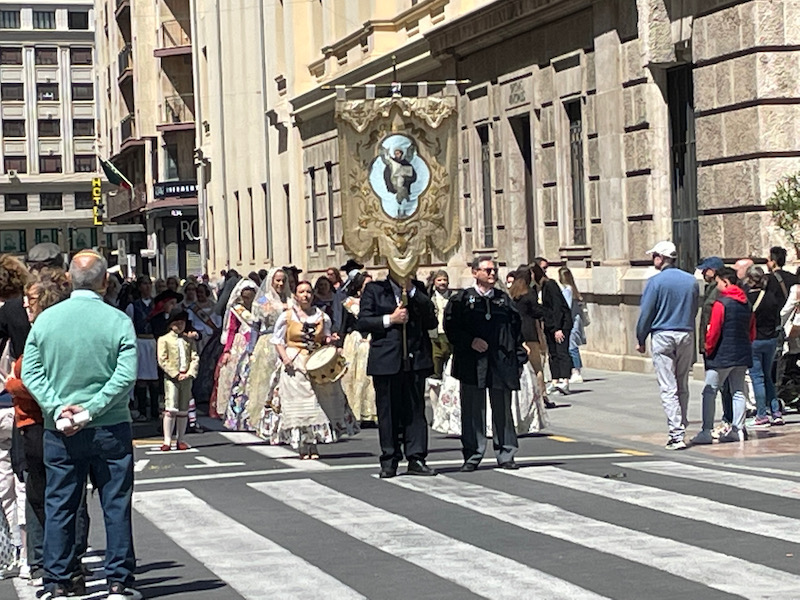

Plaça de l'Ajuntament, or Town Hall Square, is a large and relatively new square. One one side is the town hall, built in Neoclassical and and Neo-renaissance styles. Across the square is the old Post Office building, built between 1915 and 1922. Although the main façade appears symmetrical, the inside floor plan is quite irregular (although we didn't go inside). There is a huge metal tower on top with a spiral staircase.
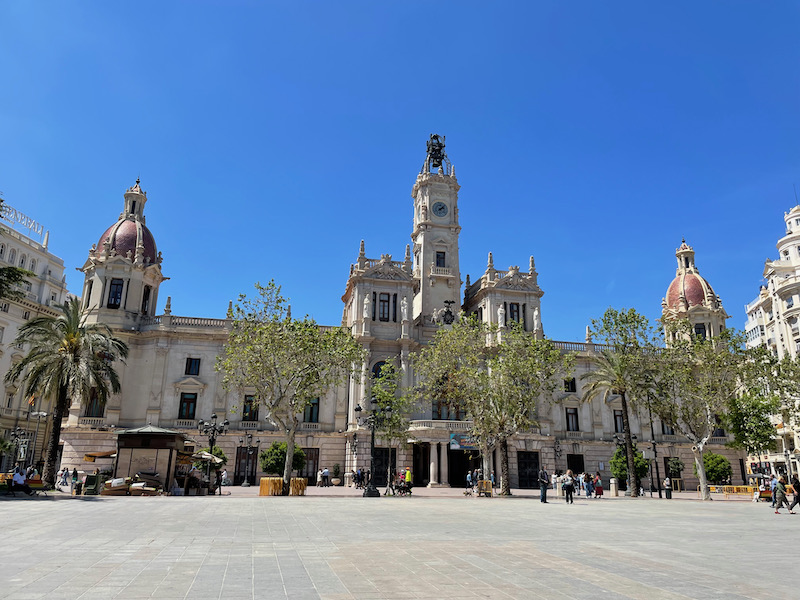
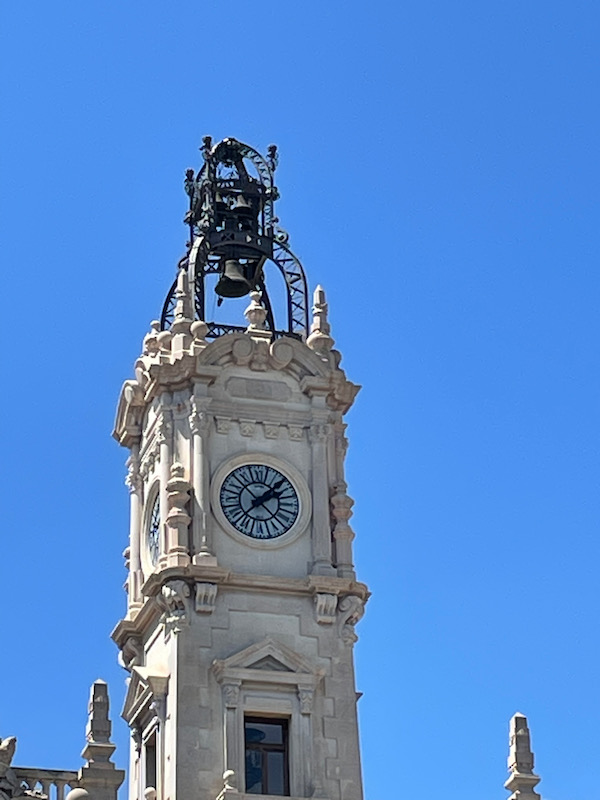
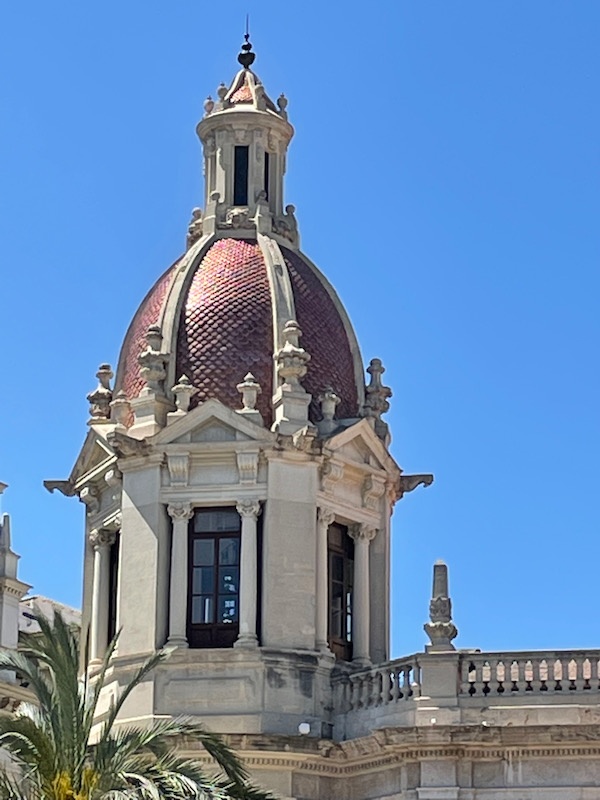
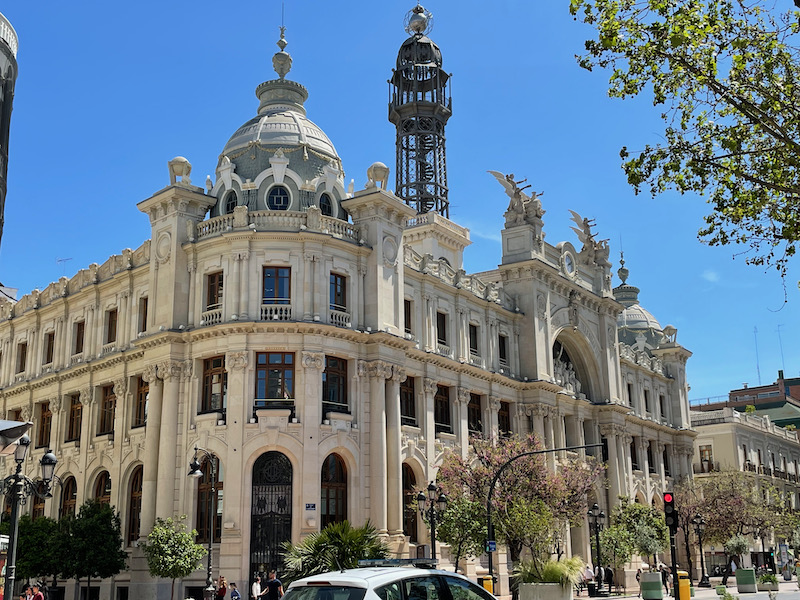
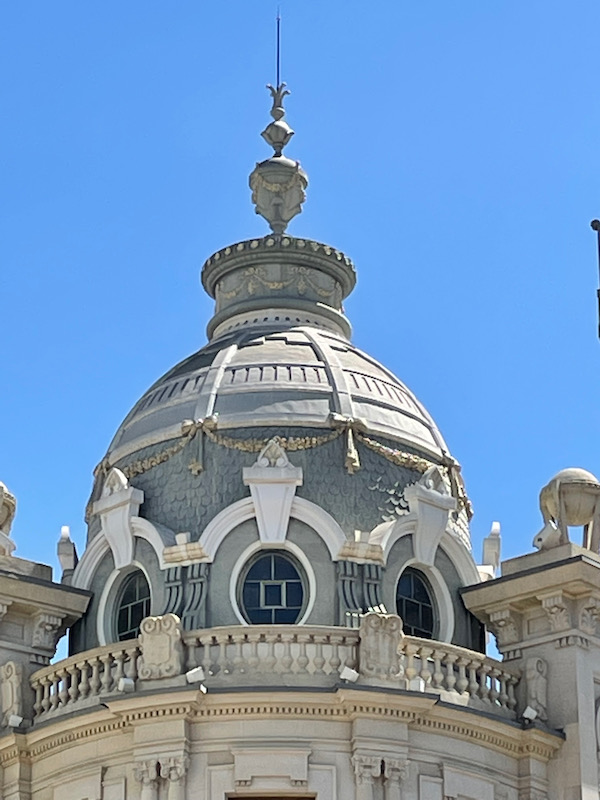
All around the square are some very interesting and lovely buildings. I'm not sure why, but the buildings in this part of Valencia all seem to be in great shape and very highly decorated. They also seem to always be rounded on the corners (not sure why!) I also added in a few other buildings not specifically on the square that also have great architecture.
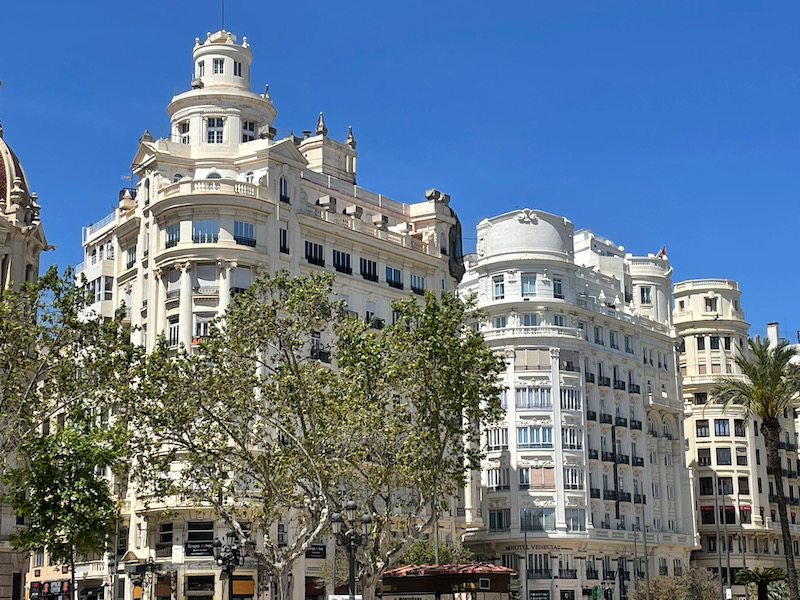
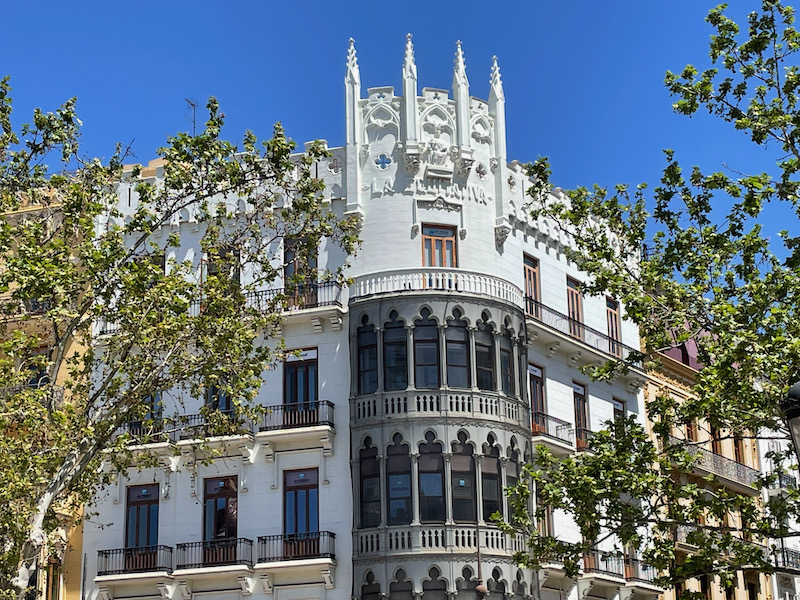
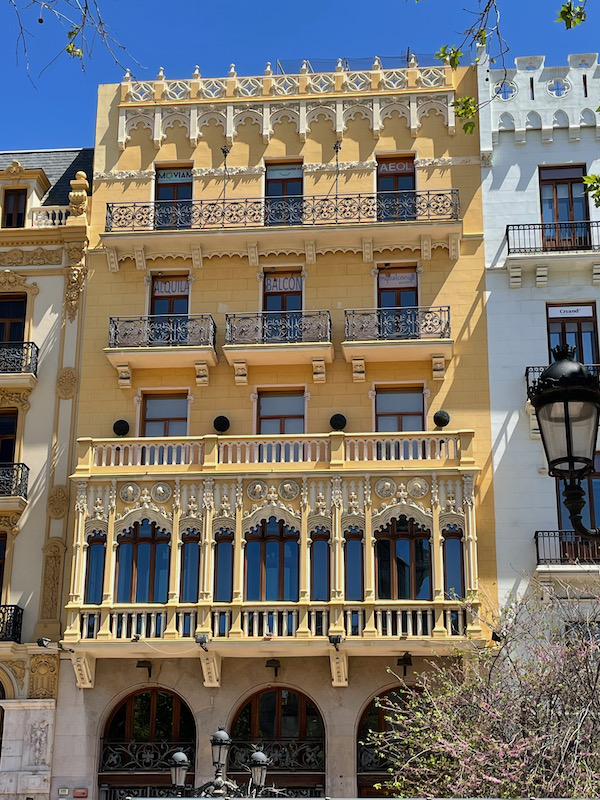
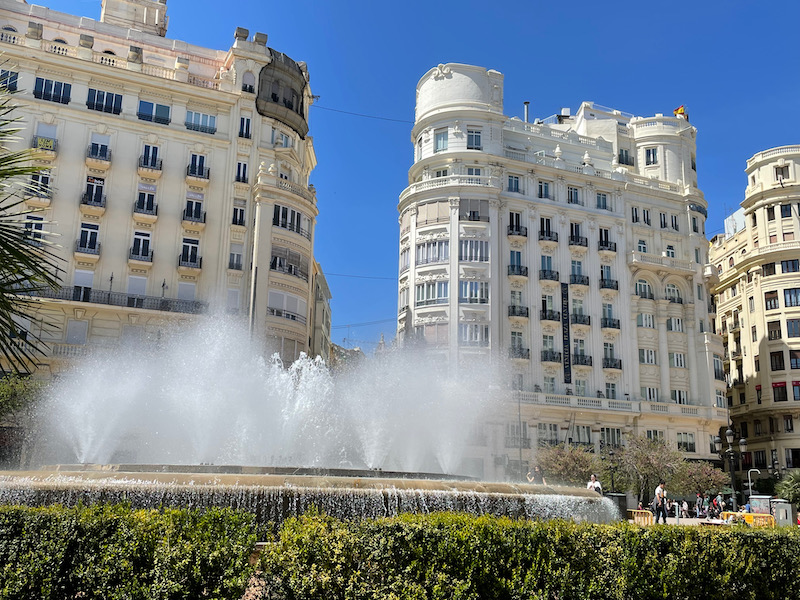
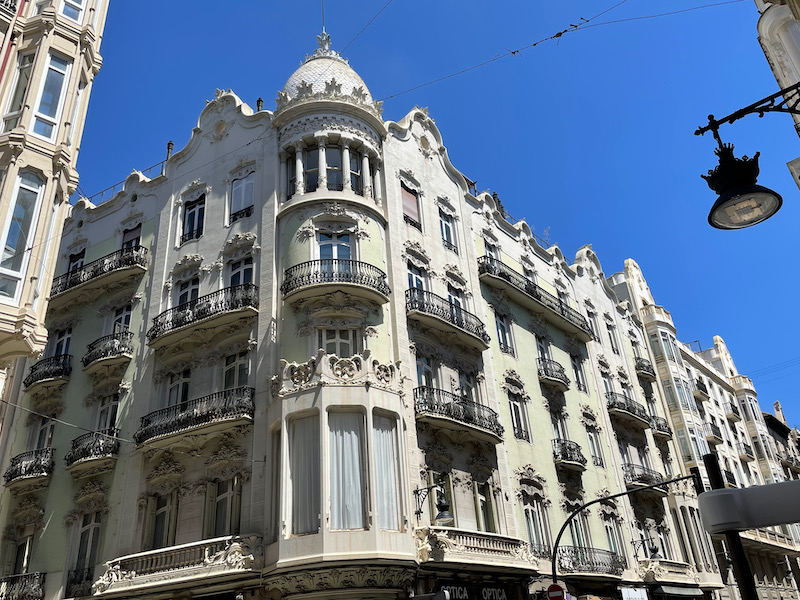
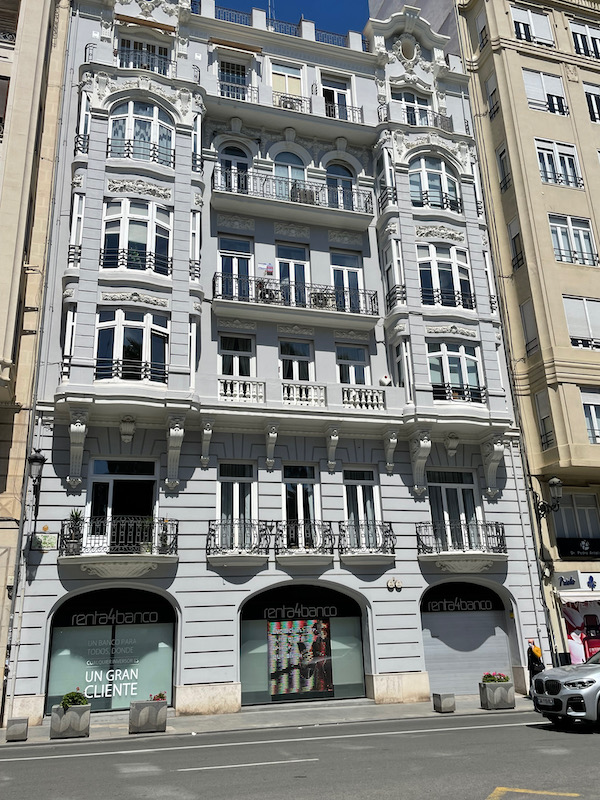
Puerta de la Mer, or Gate of the Sea, is actually a reproduction of the Puerta del Real. The original gate in the wall dated from 1356 and the last work was in 1843, changing it to a neoclassical style. It has three openings. The central one is higher and culminates in a semicircular arch, while the lateral ones, of lower height, are flat. Above these are 4 bas-reliefs depicting courage, selflessness, peace, and glory.
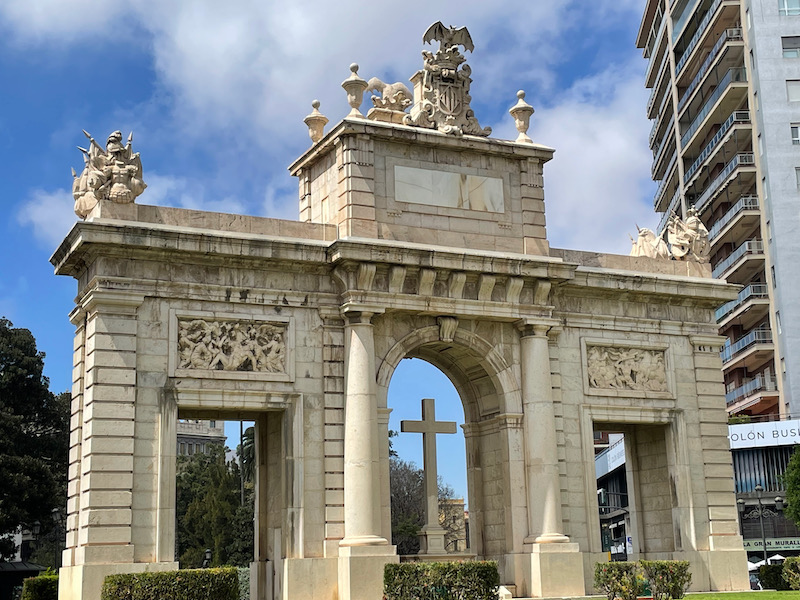
I don't remember exactly what this was ... we had walked by a sign for the "Casa Natalicia del San Vincente Ferrer", or the birth house of Saint Vincente Ferrer, but walking in, it was a little chapel. So I'm sorry but I can't tell you exactly what/were it is. But it seems to be a small chapel that is dedicated to Saint Vincent Ferrer, who was born in Valencia in 1350. According to popular legend, Vicente Ferrer achieved several miracles by raising his index finger, which is why he in pictures, he is usually represented with his index finger or hand raised towards the sky.
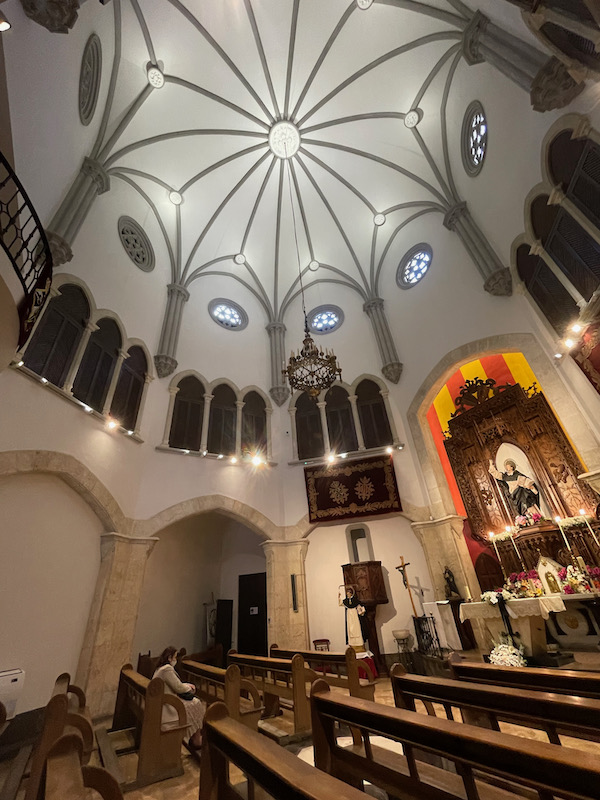
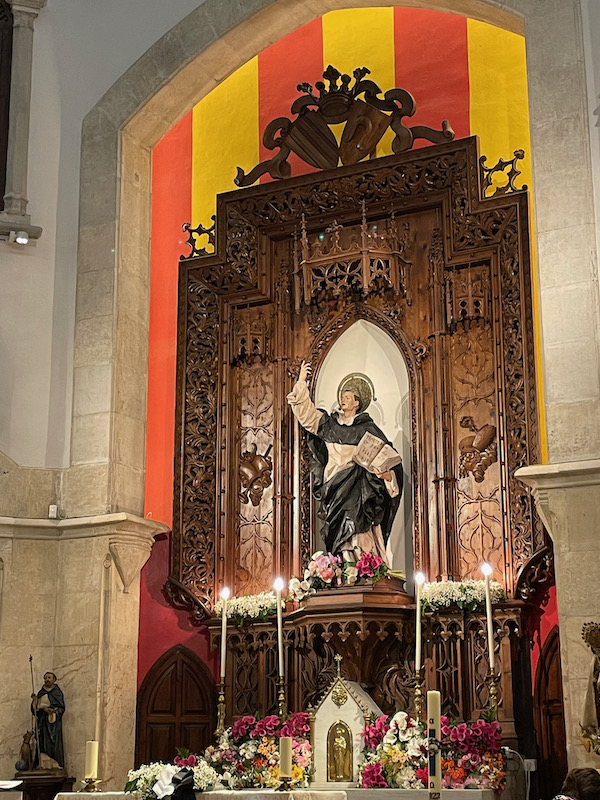
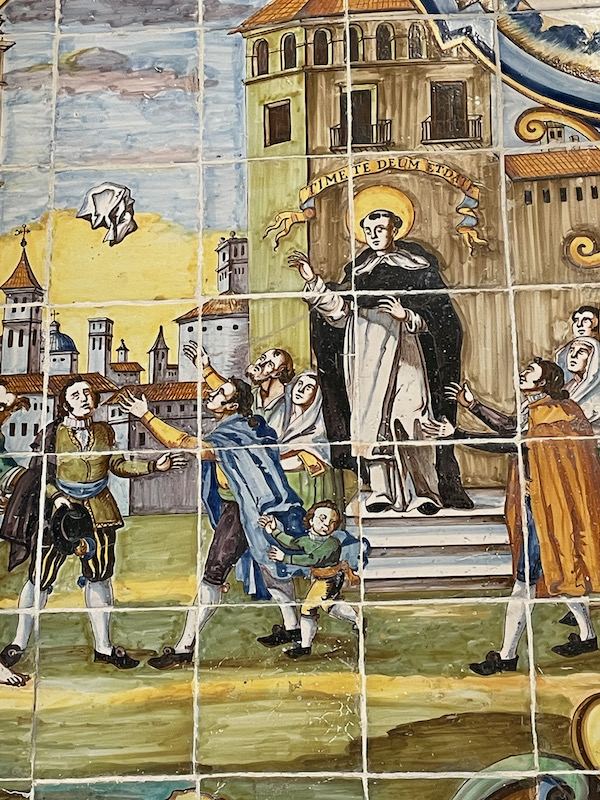
We love to go by public markets in Europe because they normally are in wonderful buildings. This one is didn't disappoint, being one of the main works of Valencian Art Nouveau. The Mercado de Colon was designed between 1914 and 1916 and put into operation in December 1916. The structure is made up of metal lattice trusses and arches made using profiles made up of riveted joints, and screws in the links with the cast-iron pillars that support the roof. Along outer arches are really nice mosaics as well as colorful tile decorations along the edges. It is now meant to be a space to relax and has quite a few little cafes.
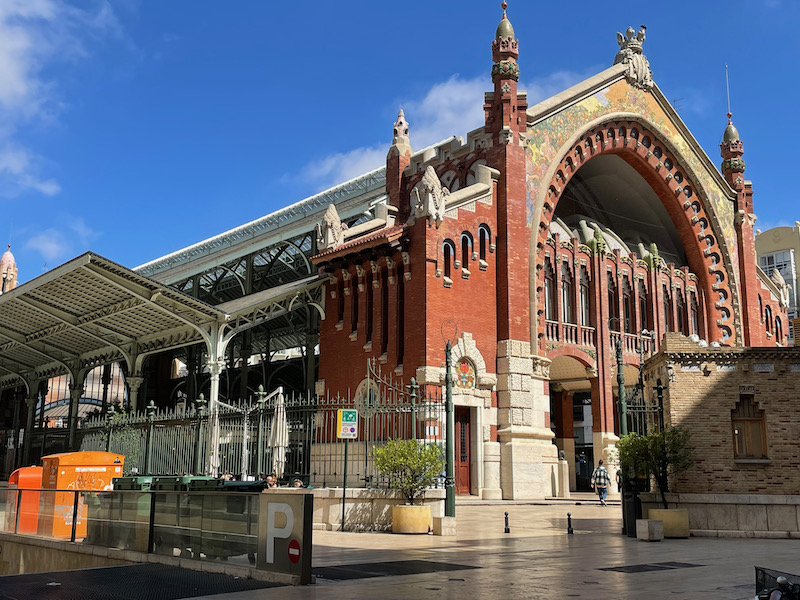
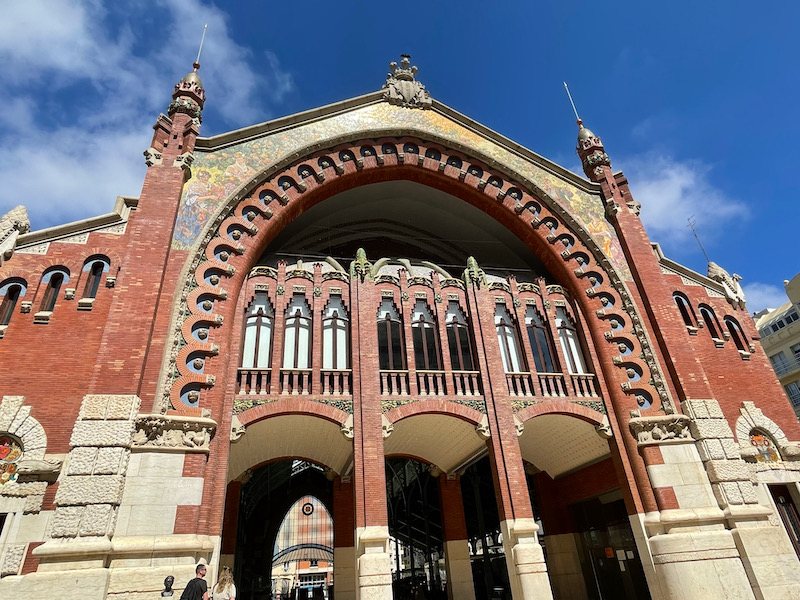
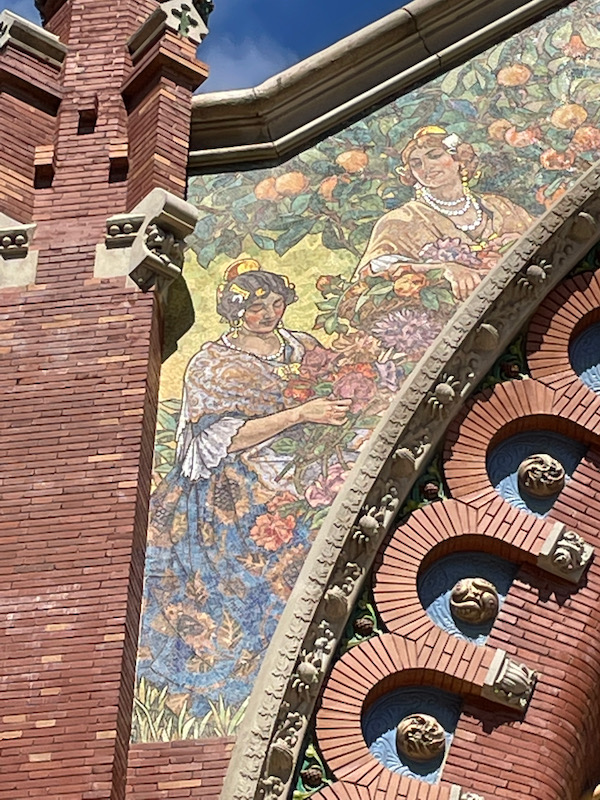
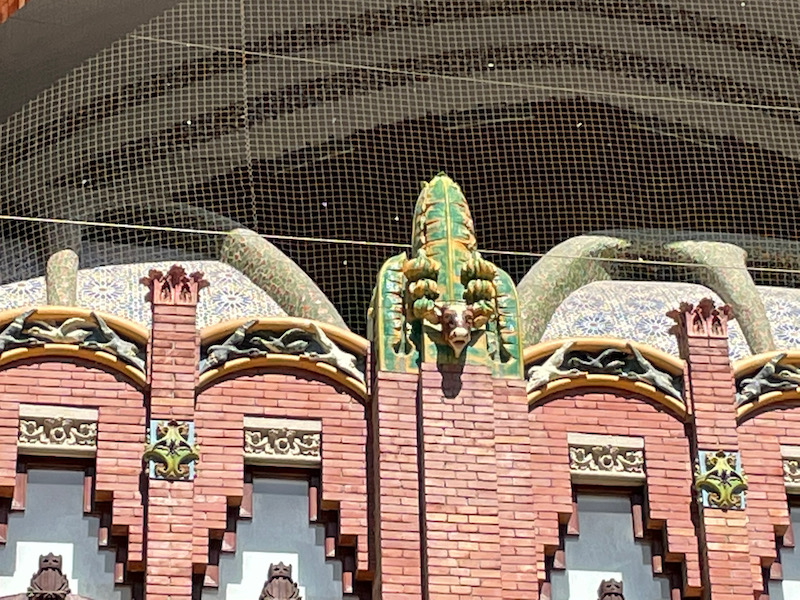
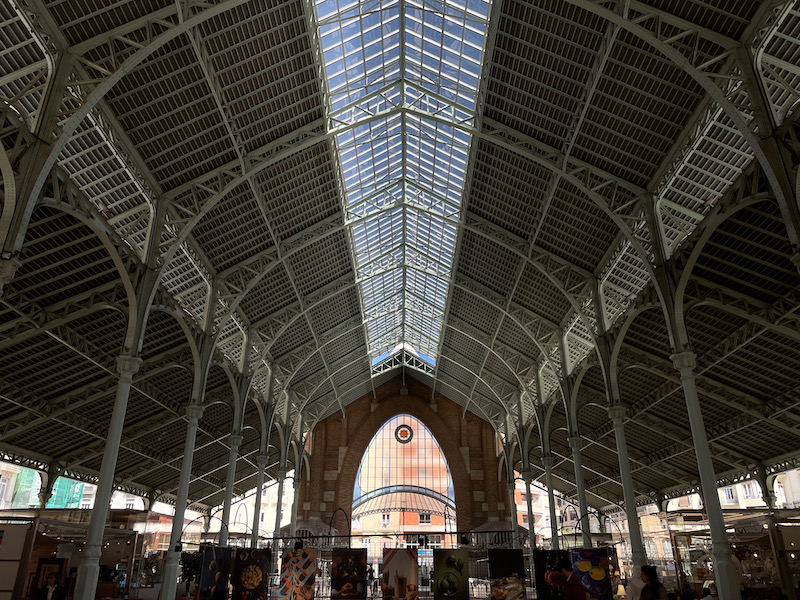
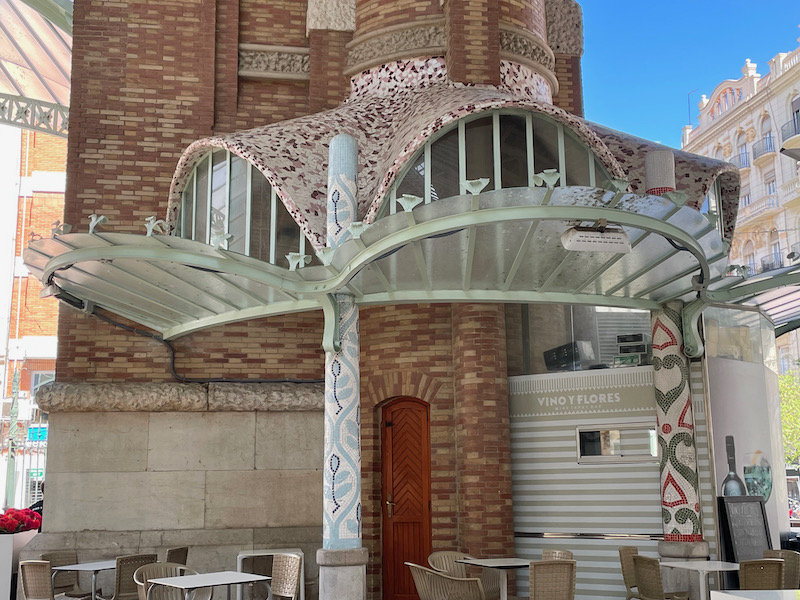
Our hotel was near the Placa de Bous, which is the bullfighting arena. It was built between 1850 and 1859 and the design was inspired by civil Roman architecture such as the Colosseum in Rome or the Arena of Nîmes in France. It had 384 external arches and is what is called the Neo-Mudéjar style,
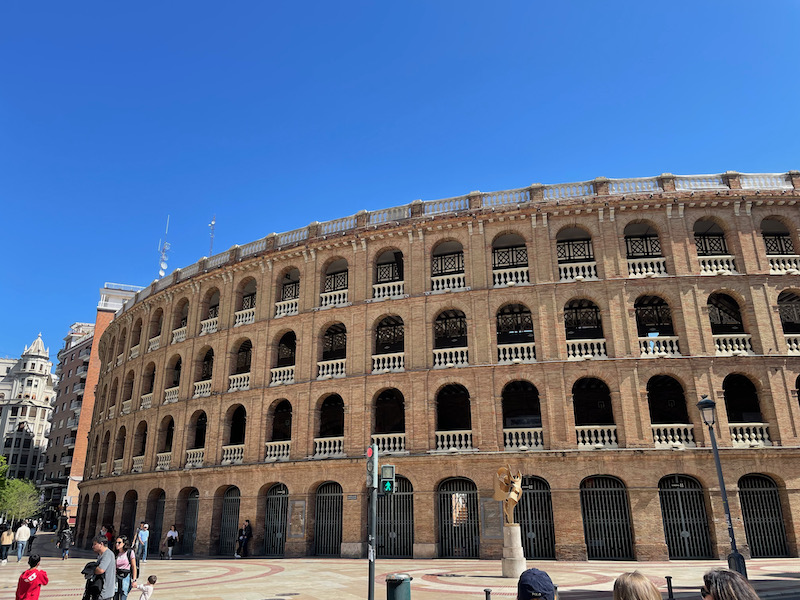
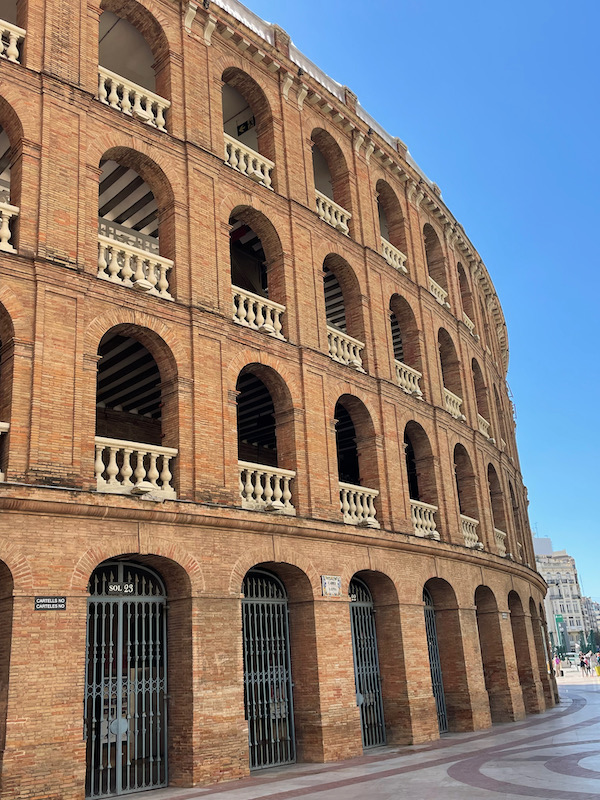
For me, this is one of the most amazing train stations that I have seen. It is the Estació del Nord, which sits next door to the Placa de Bous. It is another Valencian Art Nouveau buildings, inaugurated in 1917. There are 3 bowers on the main façade.
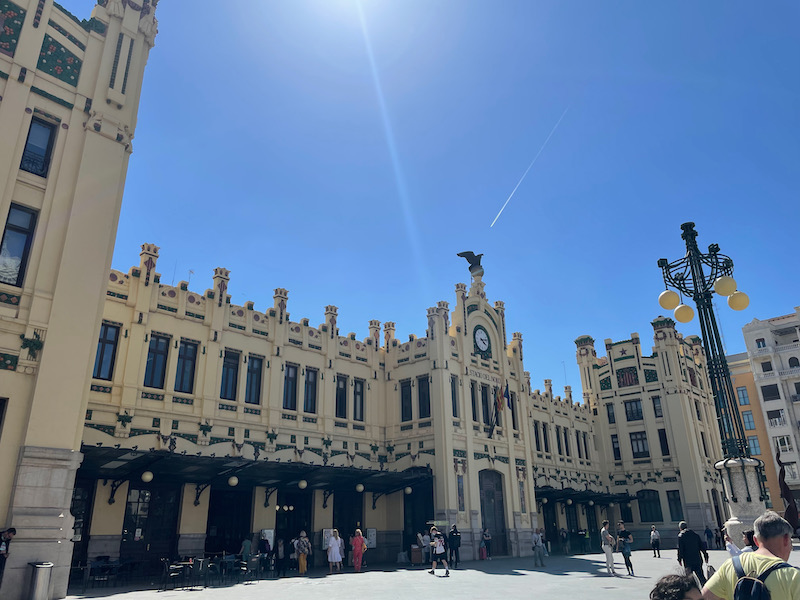
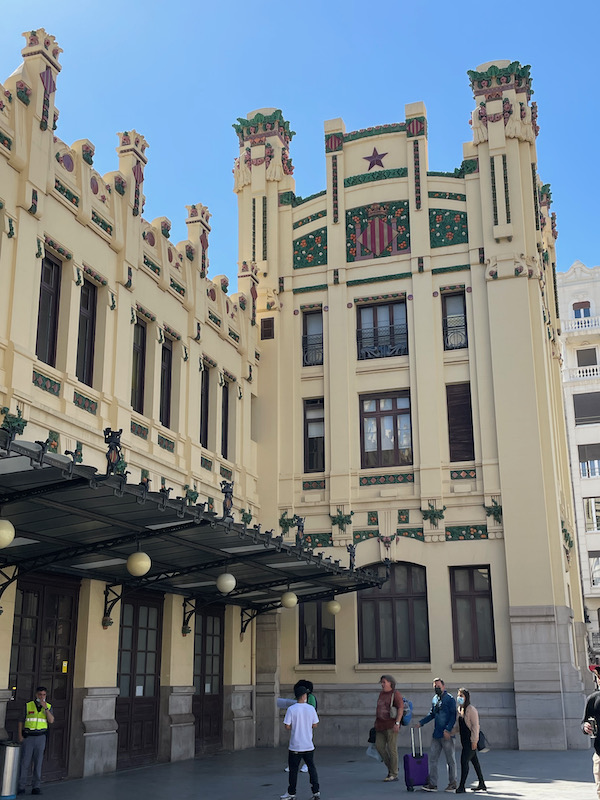
The interior is decorated with glazed ceramics and mosaics. The lobby is quite impressive, with wood, glass, and marble. The columns are topped with plant motifs, oranges, and orange blossoms, which are inspired by Valencian agriculture.
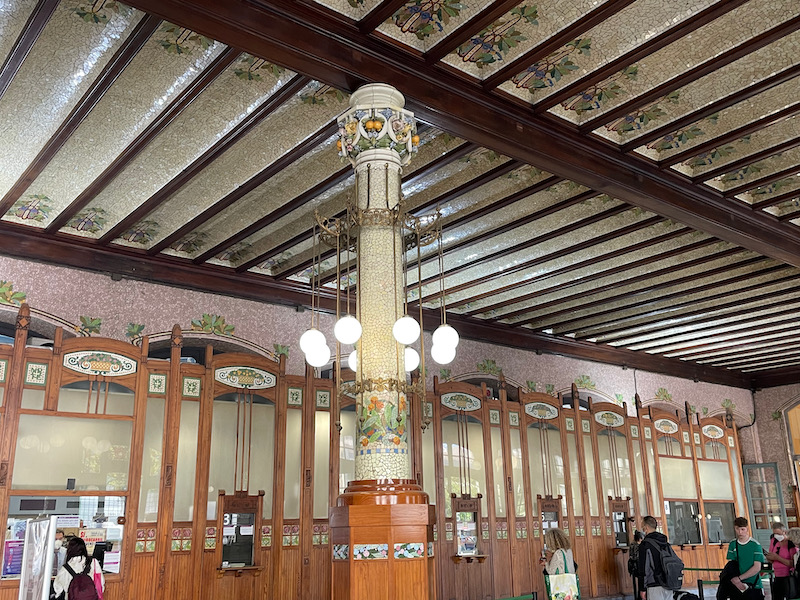
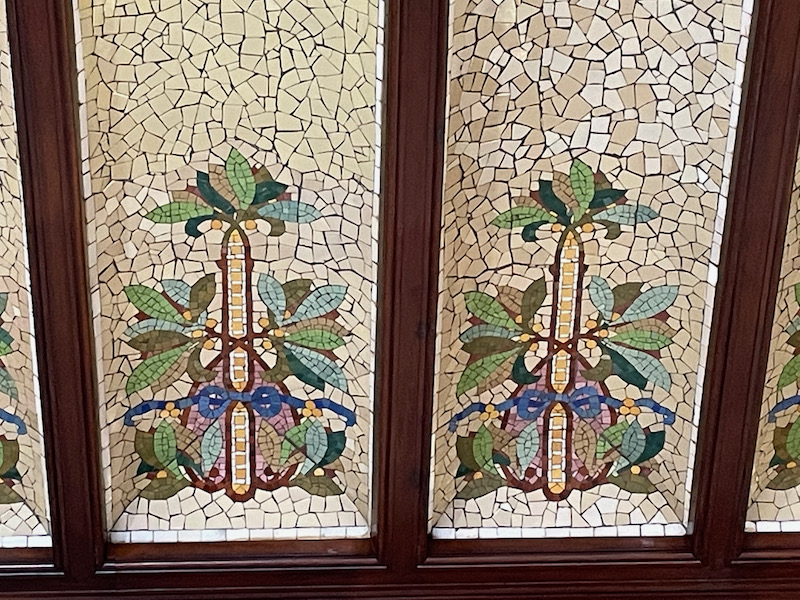
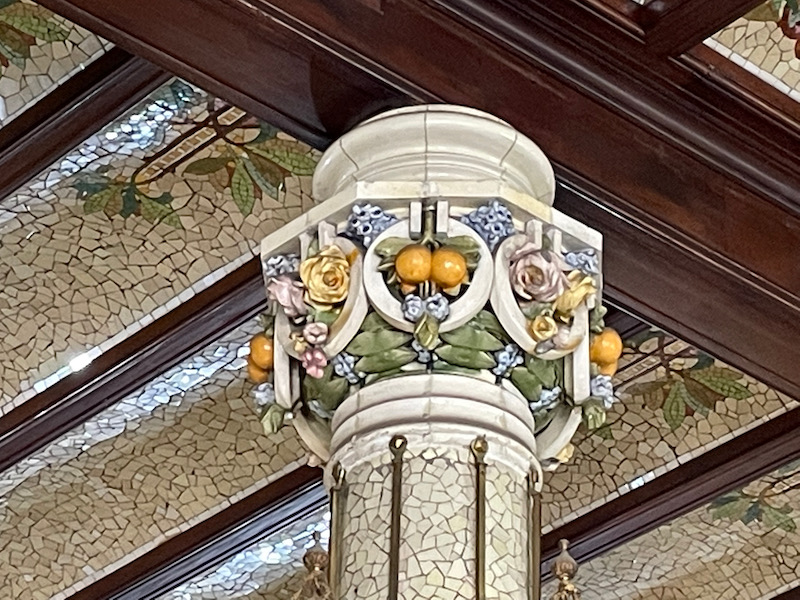
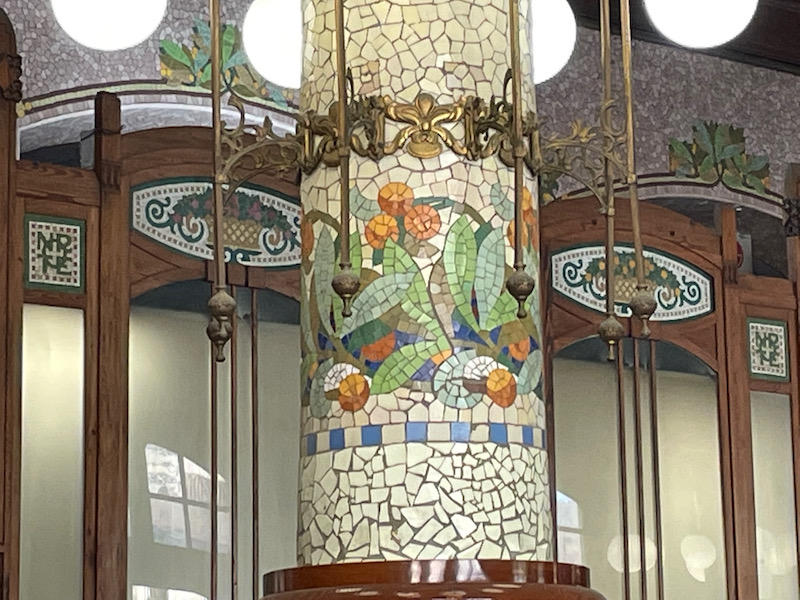
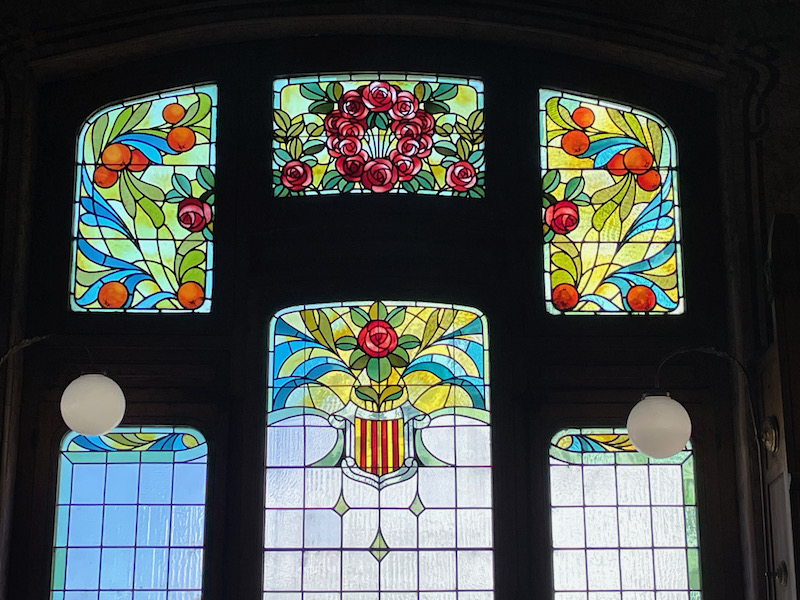
And another few pictures of the amazing tile work and mosaics.
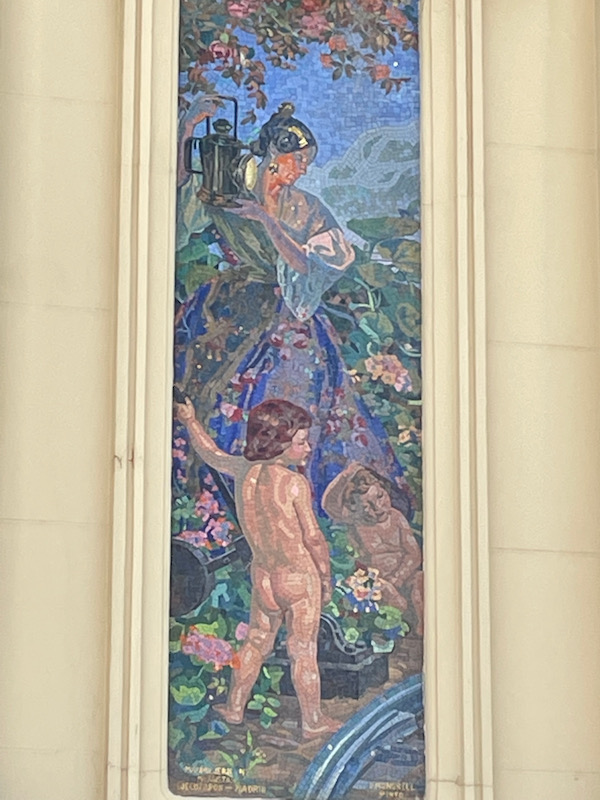
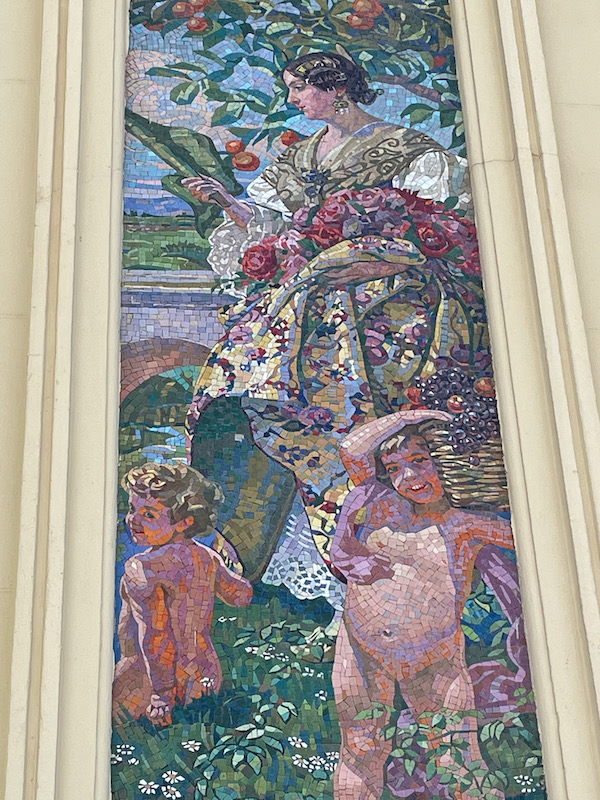
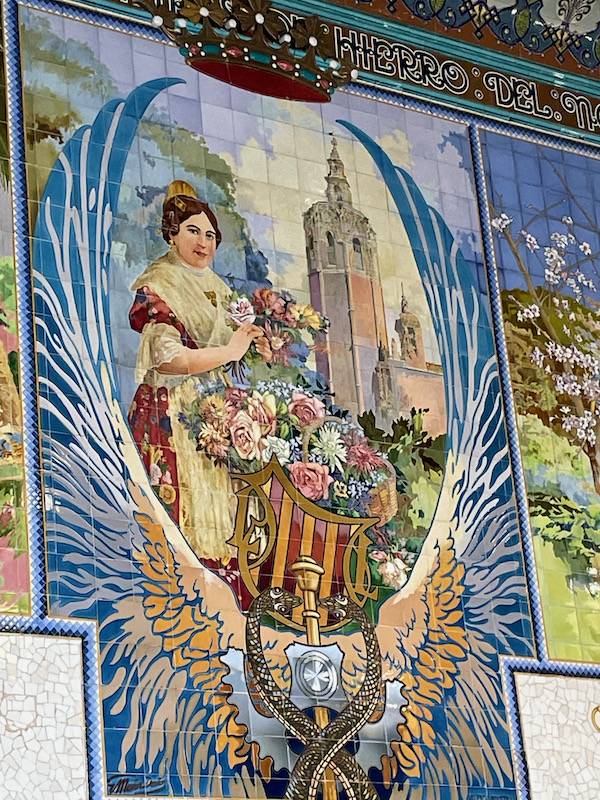
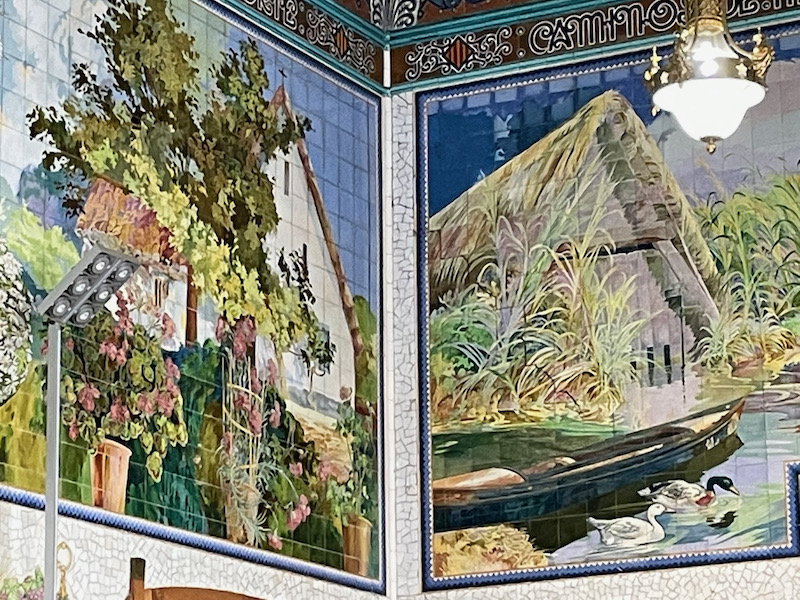

The Central Market is the largest fresh produce market in Europe. The building is made up of iron columns reminiscent of the Eiffel Tower, earthenware and stained glass. The decorations show the products of the vegetable gardens, orchards and gardens of Valencia.
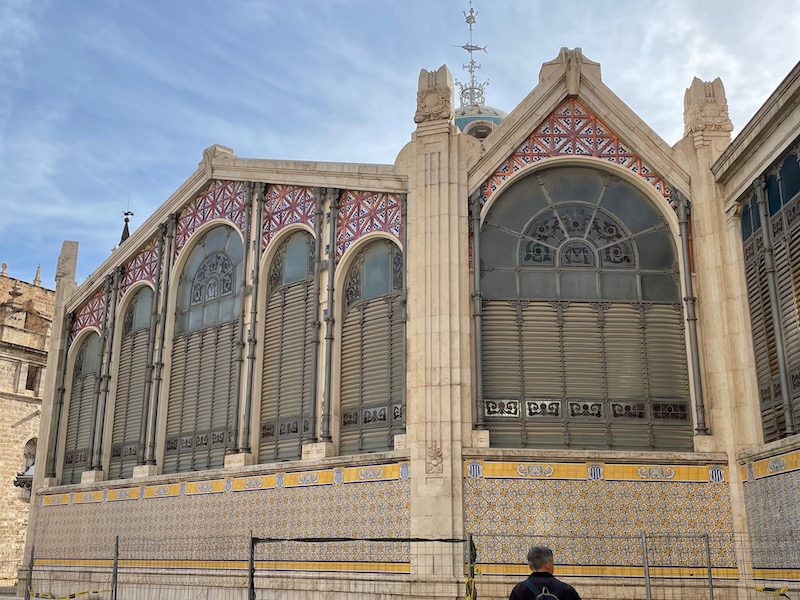
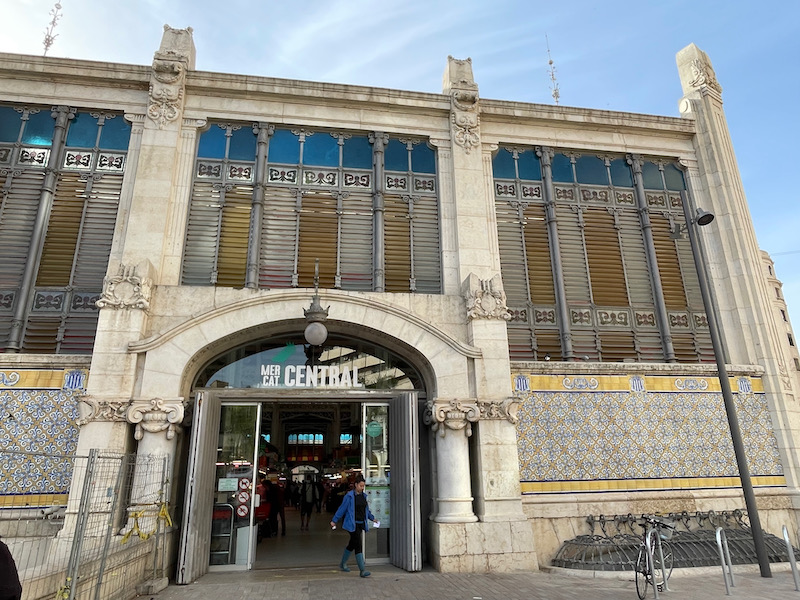
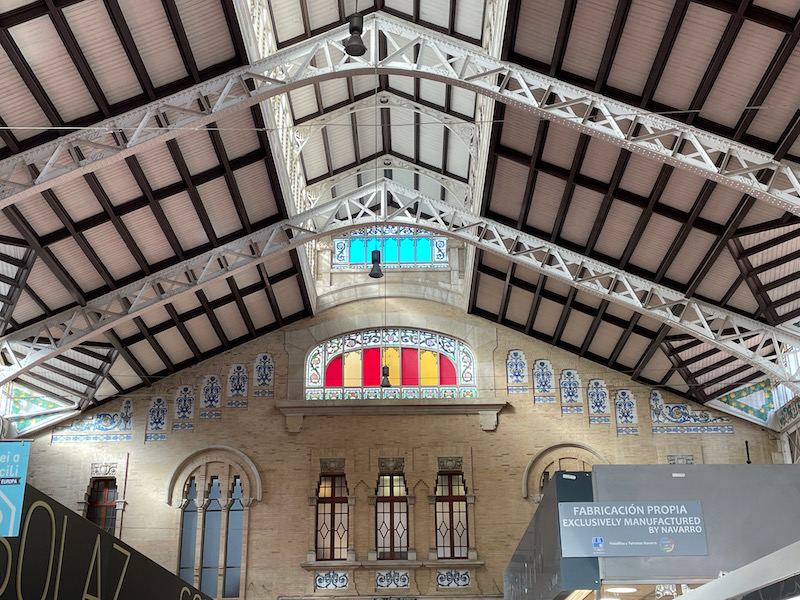
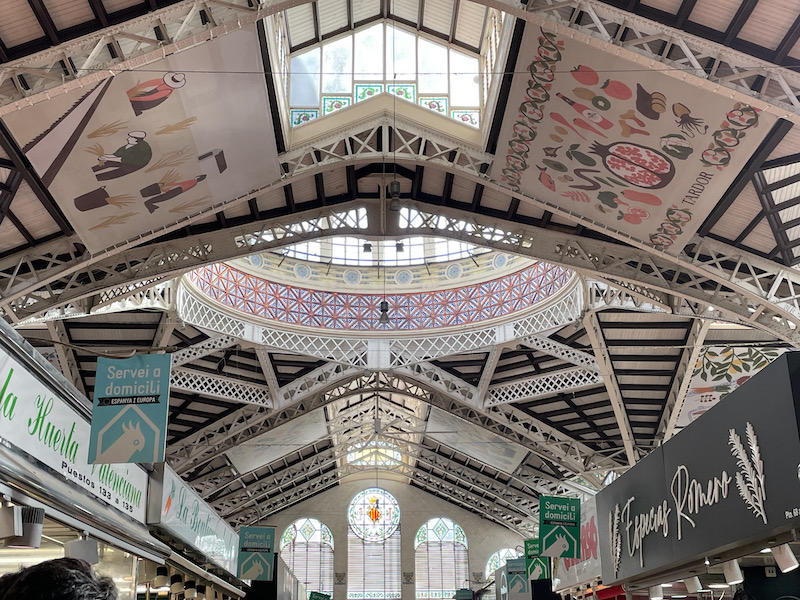
Torres de Quart is one of the two remaining fortified gates from the medieval wall. It has 2 semi-round towers with a central body where the door is. They were built between 1441 and 1460 and have withstood the War of Independence from the French, the War of Succession, the cantonal wars, and the Spanish Civil War. While circular from the outside, the inside is flat and open, almost like they weren't finished. On this inner side, there are a series of open rooms, covered with ribbed vaults. A bit of trivia: In the past, Napoleon entered the city of Valencia from here, having bombed the location rather heavily. It is still possible to see the damage that was caused by cannon fire from the French during in 1808.
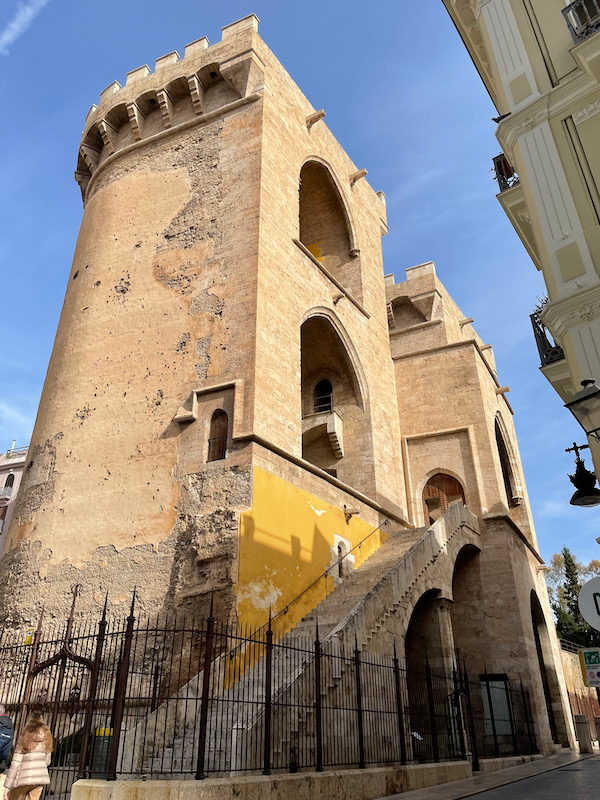
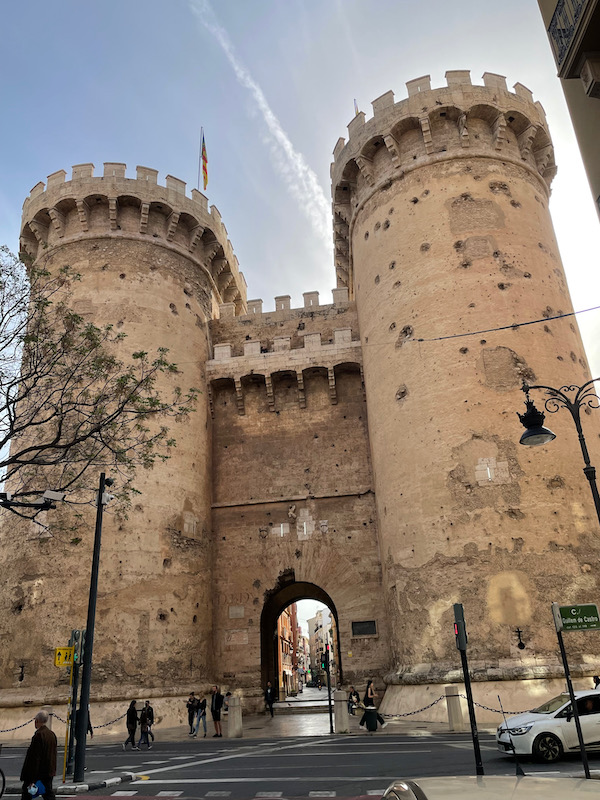
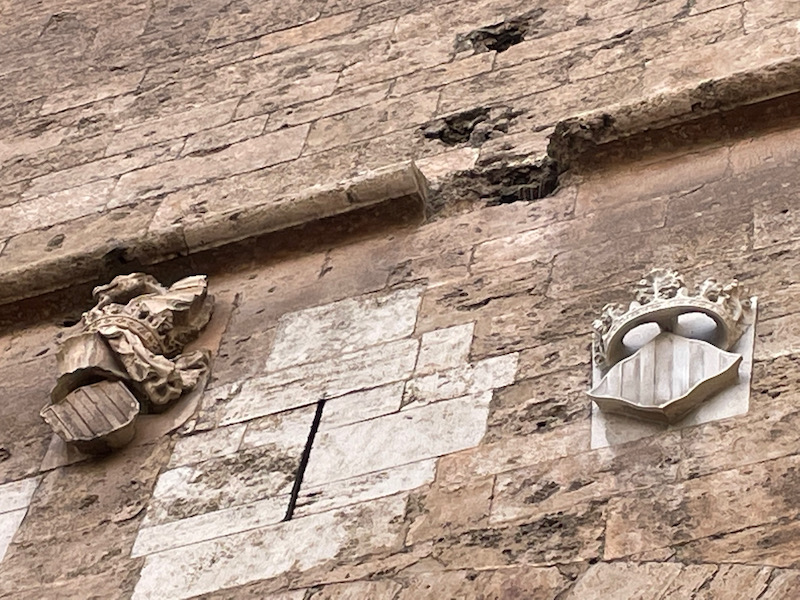
Porta de Serranos, or the Serranos Gate, is the largest of its kind in Europe. It was completed in 1391, making it older than the Torres de Quart. The towers were part of the defensive structure protecting the city although later, they were used to house prisoners. The structure is pentagon-shaped and has a common gallery that connects the two sections. Looking from the back (so from what would have been inside the walls, you can see the various rooms on either side with Gothic arches and ribbed vaults.
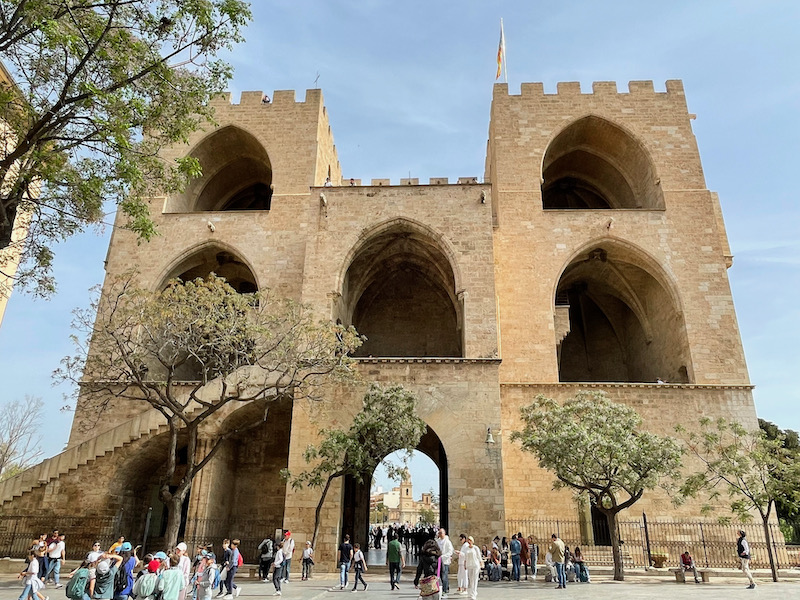
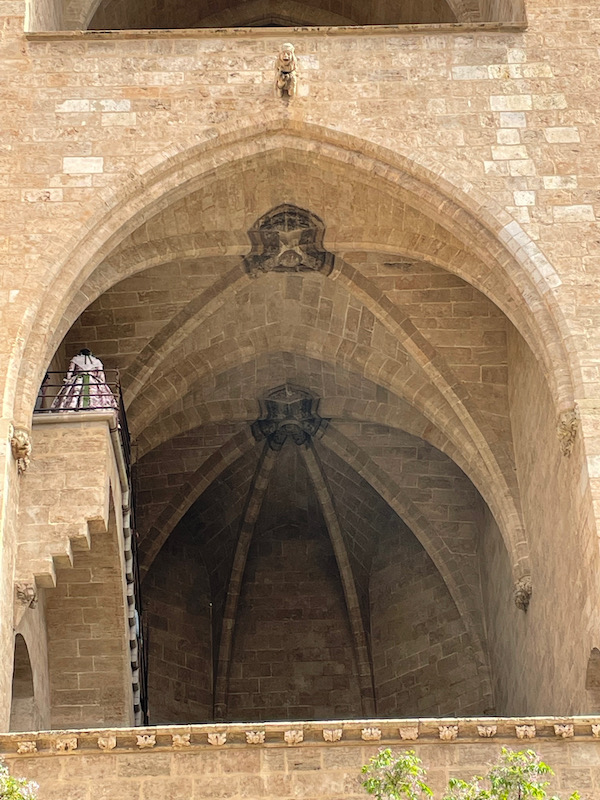
Moving around to the front, you can see the really intricate decorations and what used to be the moat.
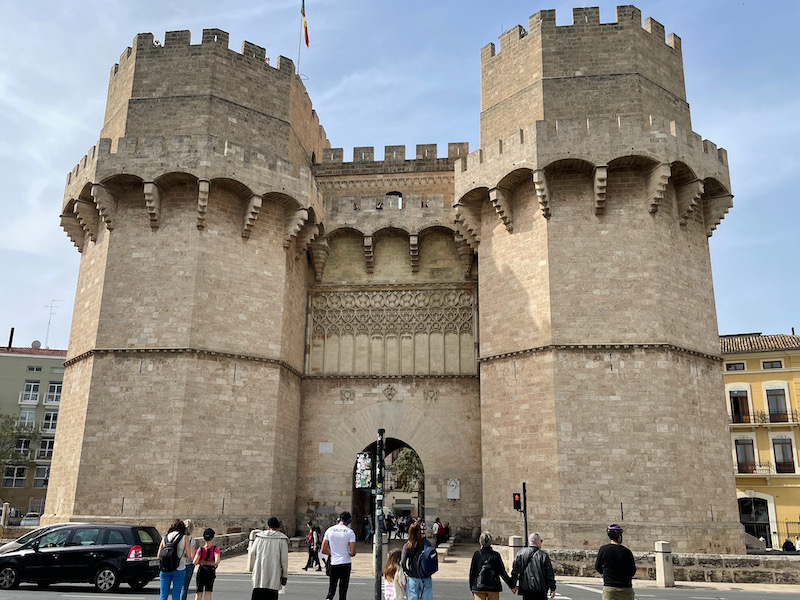
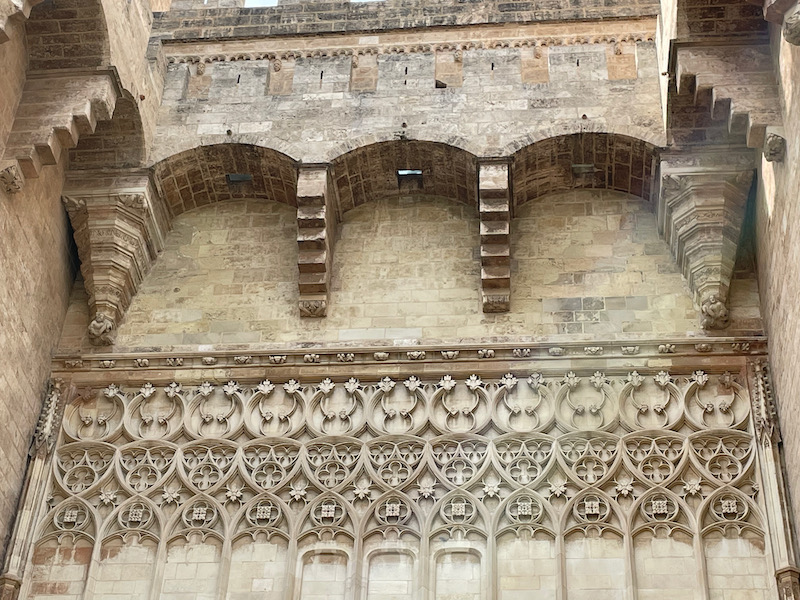
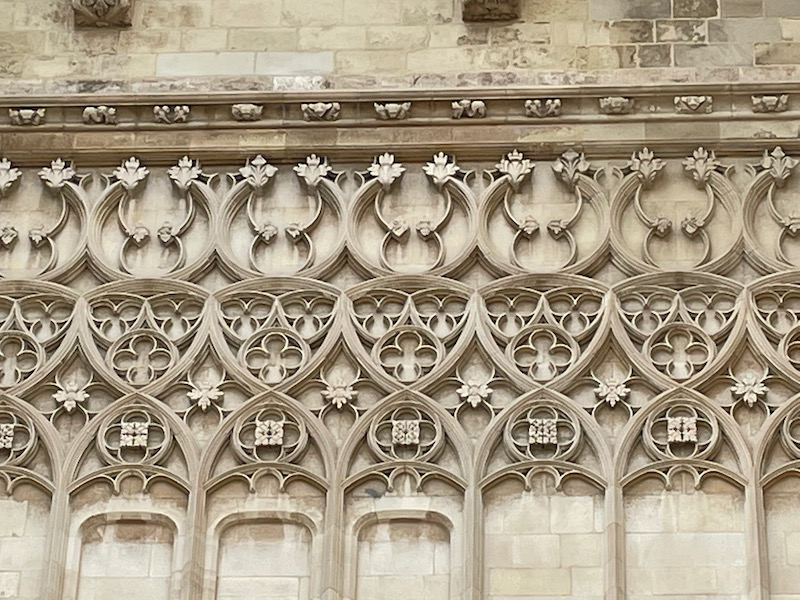
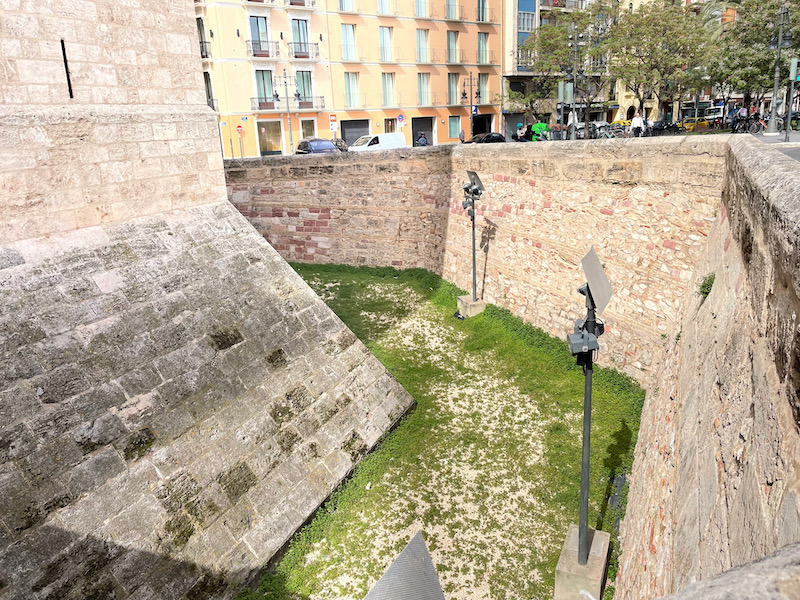
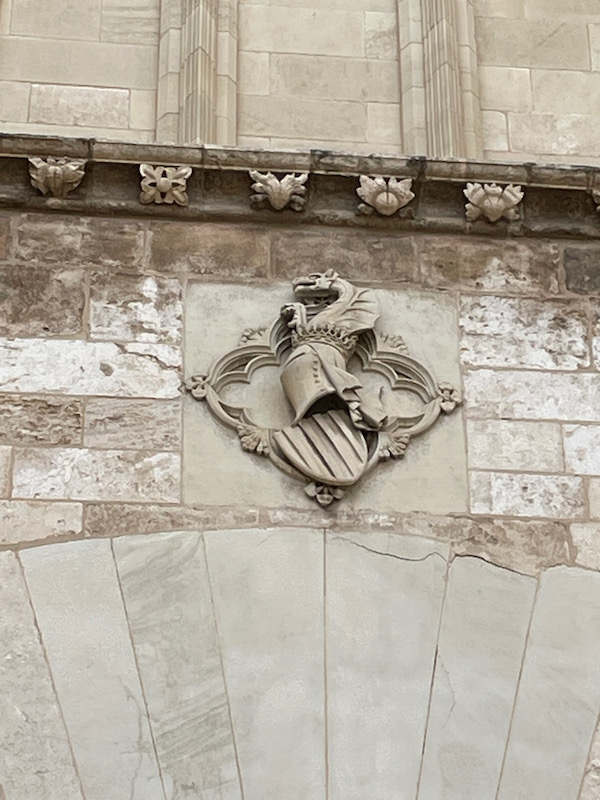
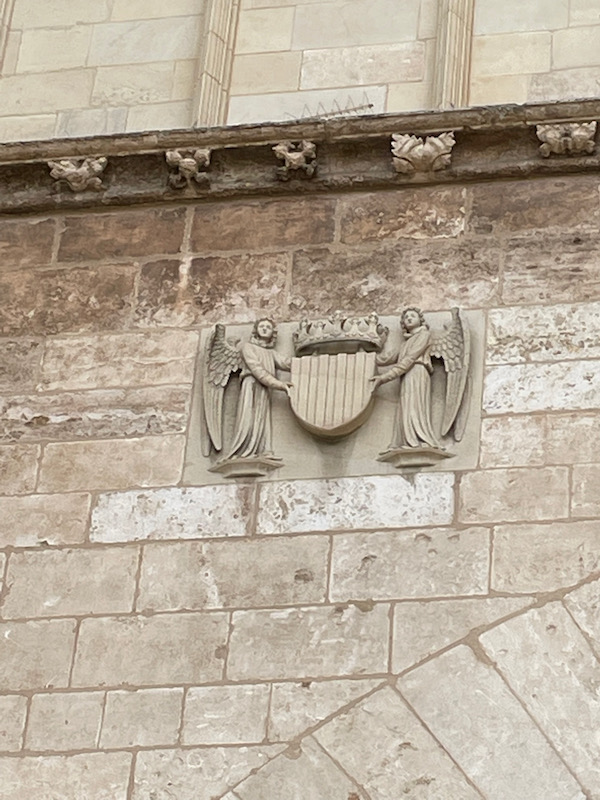
Plaza de la Virgen, or Virgin Square, offers a beautiful fountain from 1976 that is dedicated to the Turia River. While Neptune sits in the middle, 8 female figures pour water from the pitchers they hold.
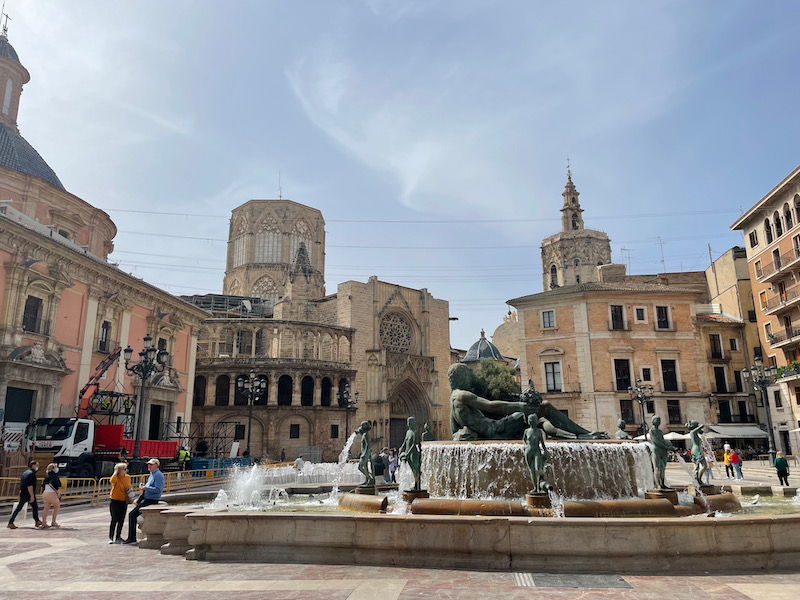
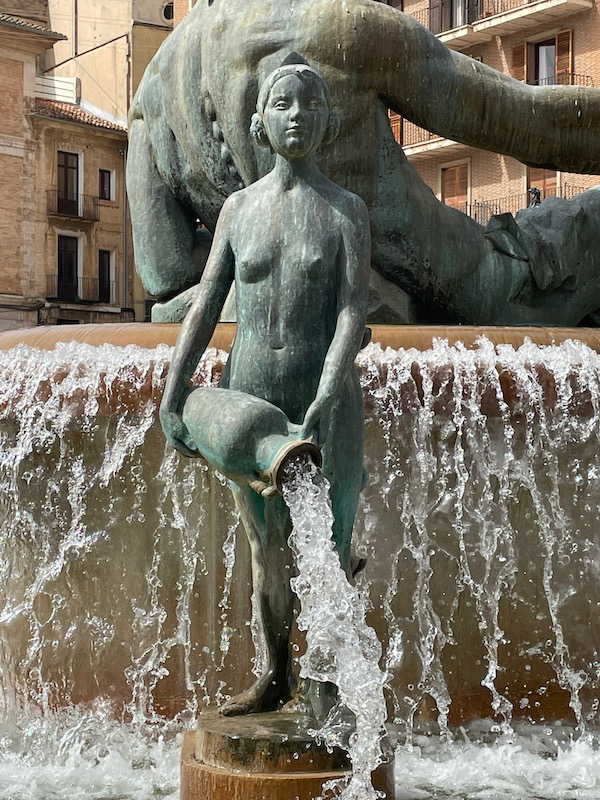
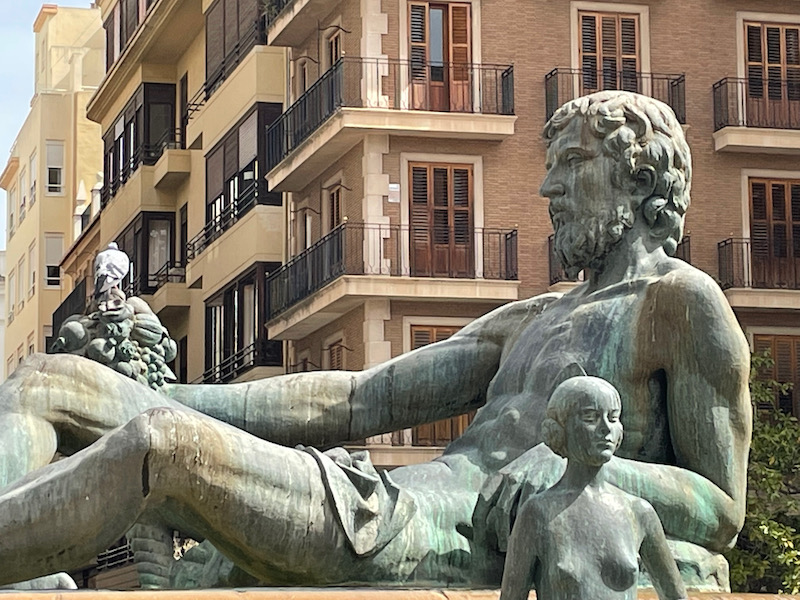
The Church of Santa Catalina is one of the oldest in the city, built in the early 13th century at the site of a prior mosque. It has a 16th-century portal in classicist style but the most notable thing is the 17th-18th century Baroque bell tower (started in 1688 and finished in 1705). It is 5 stories tall, crowned by a small dome-covered temple. Its hexagonal shape is similar to the Miguelete tower, adjacent to the Cathedral.
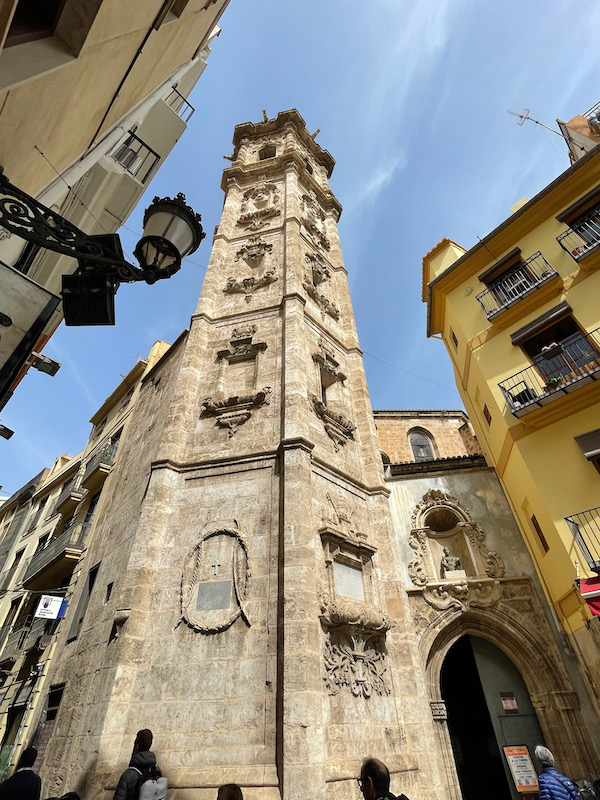
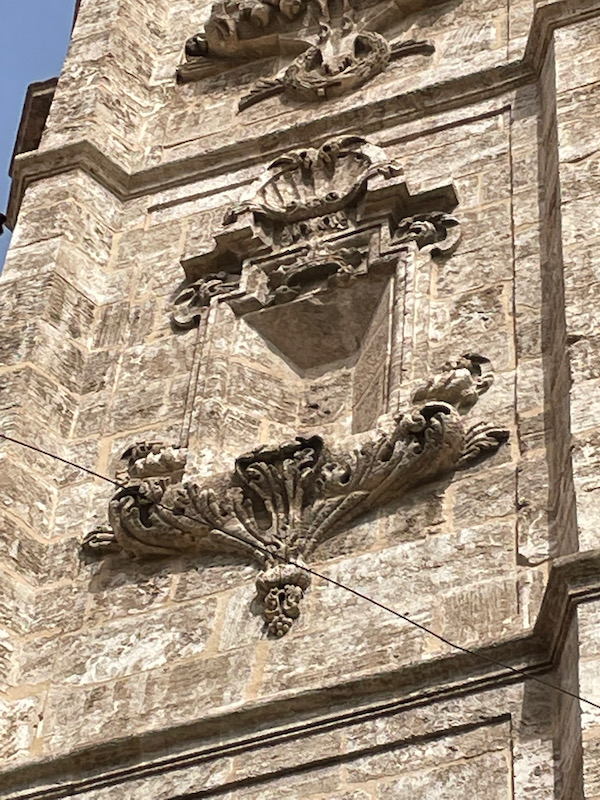
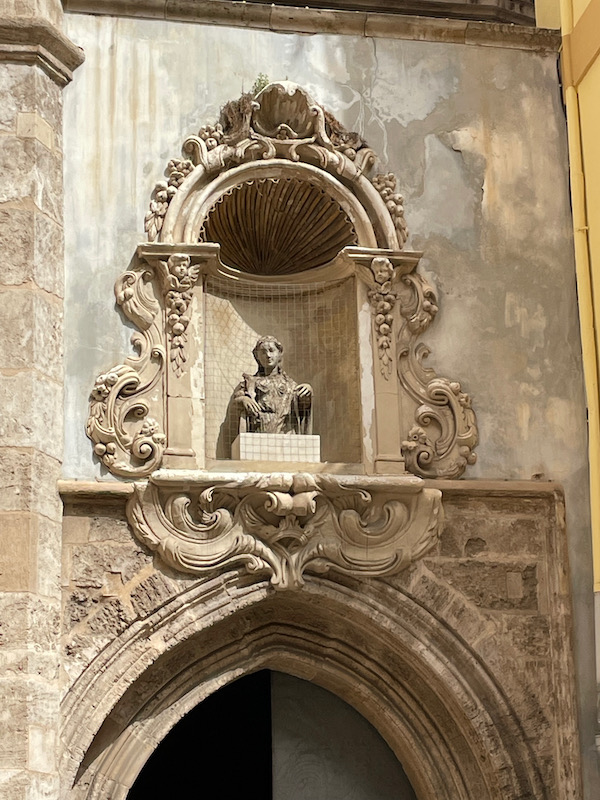
The church is composed of three naves with side chapels, crosspiece domes and the apse which includes a chapel. Most of the interior was rebuilt after a fire in 1548 in the "style of the day", Baroque, but there are still Gothic arches, ribbed vaults, and altars that are still visible. There is also a really nice painting in a cupola.
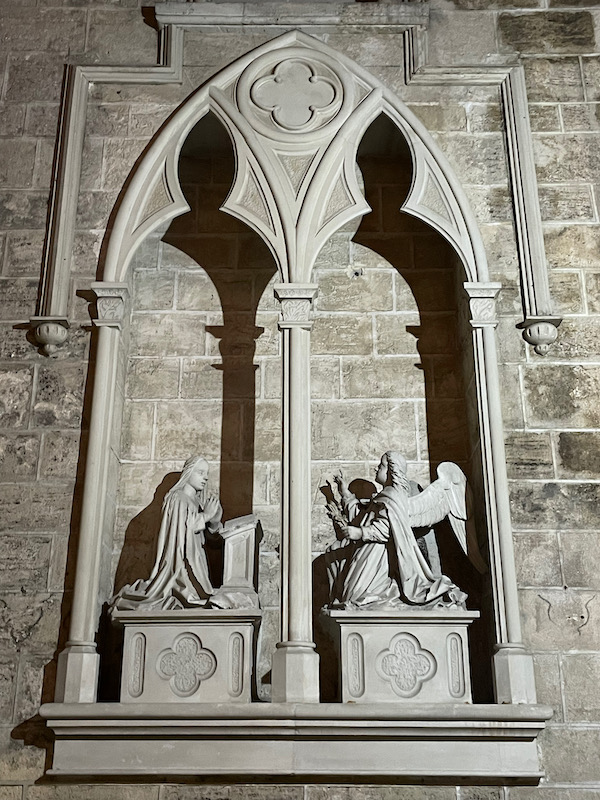
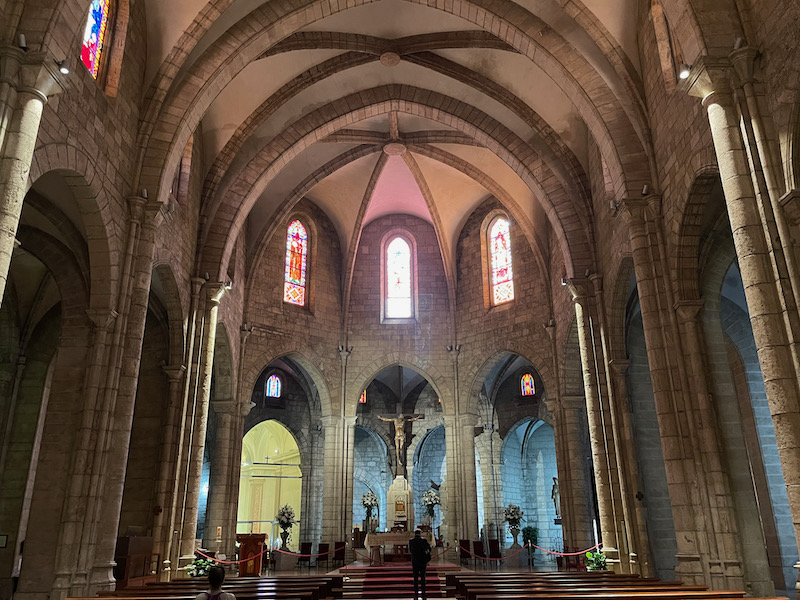
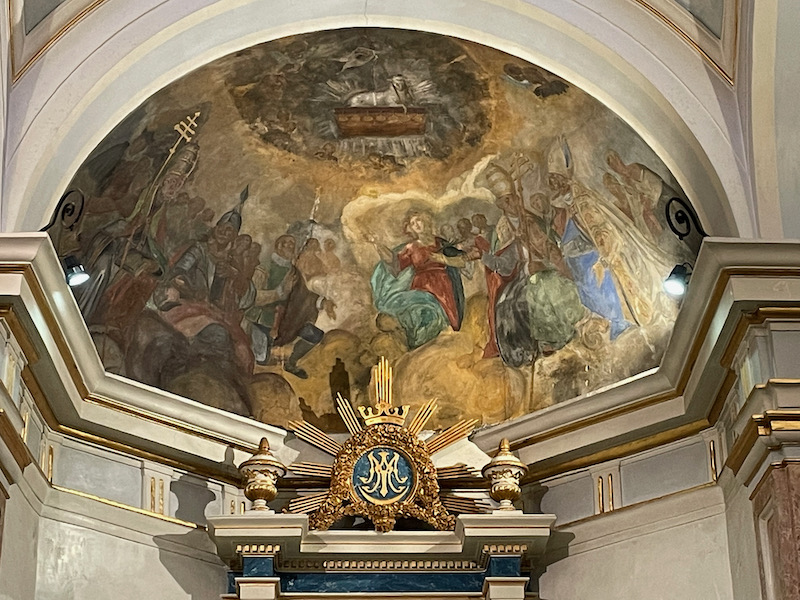
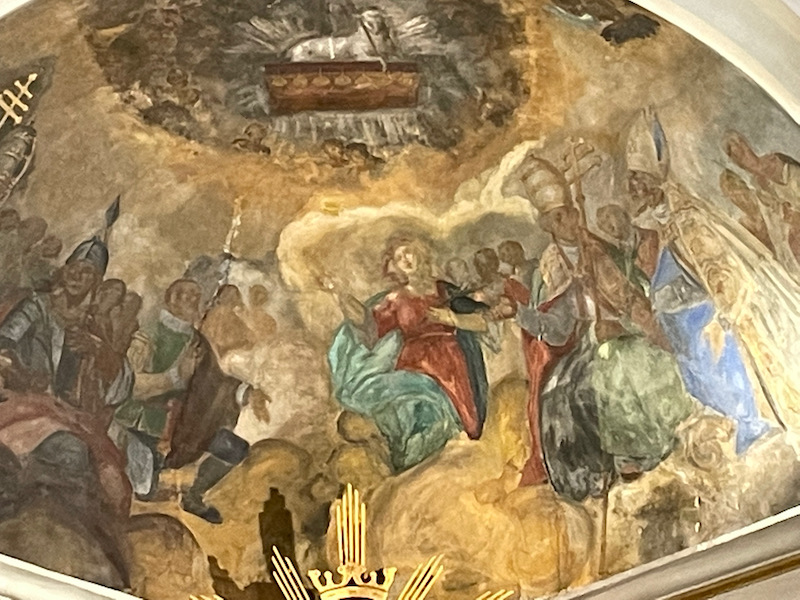
The Lonja de la Seda was built between 1482 and 1533. While the name means Silk Exchange, it was originally the Stock Exchange. Built in the late Gothic style, it illustrates the power and wealth of the city at that time. On the upper part of the main pavilion are 8 windows (one of them not really a window). Below each window is the coat of arms of the city and the frieze above has medallions representing kings, emperors, and other characters. The sculptured doors and windows are very nice, and some of them are a little humorous.
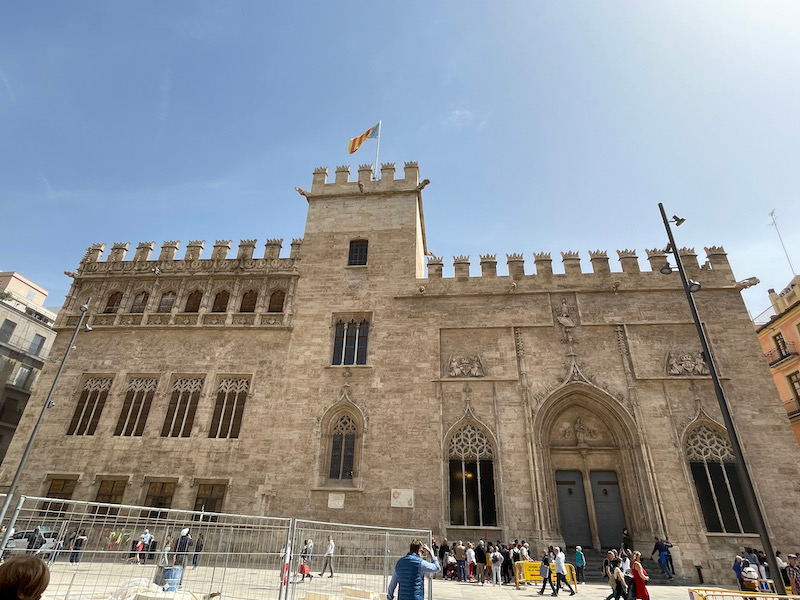
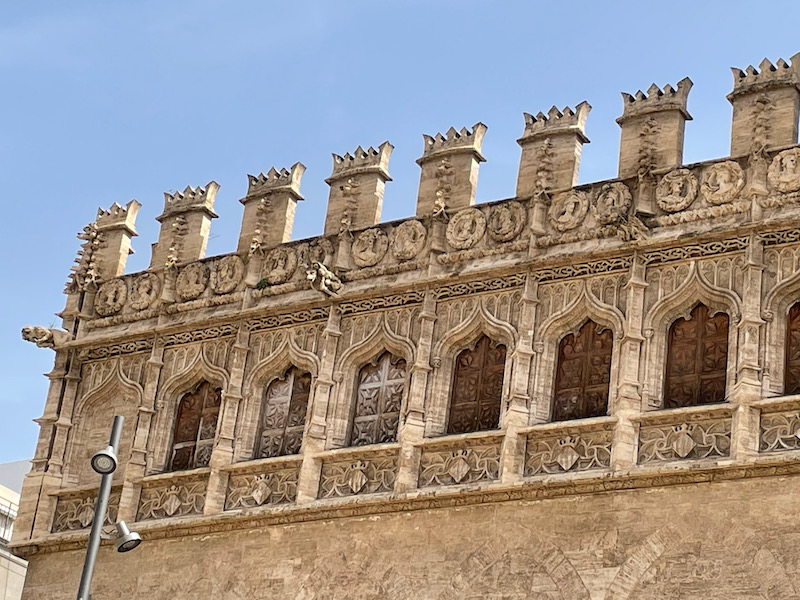
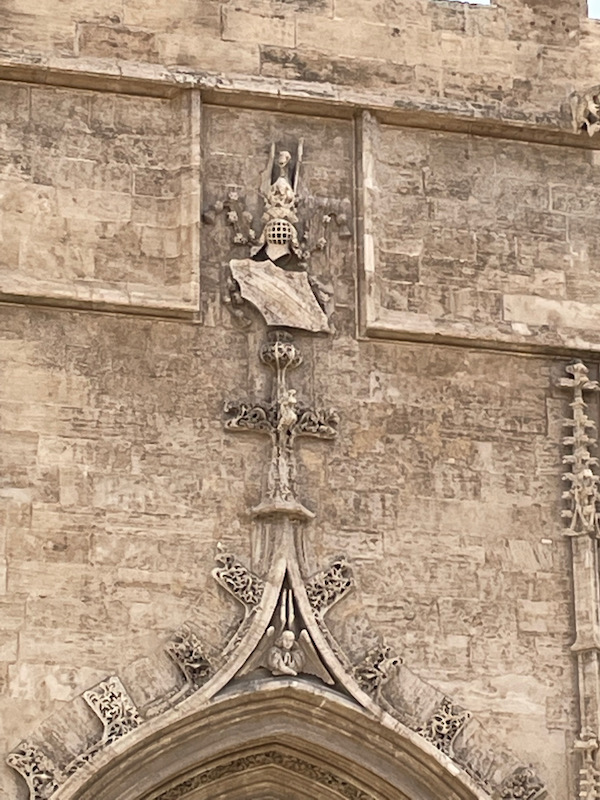
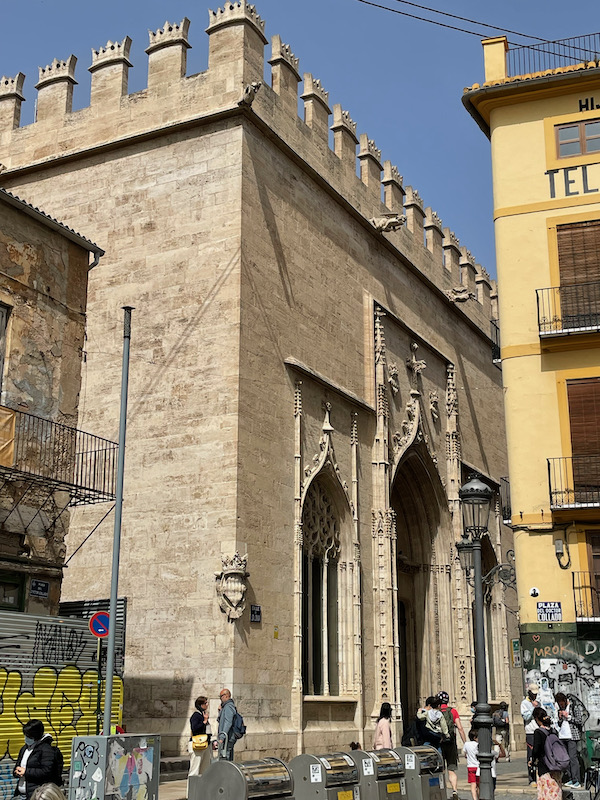
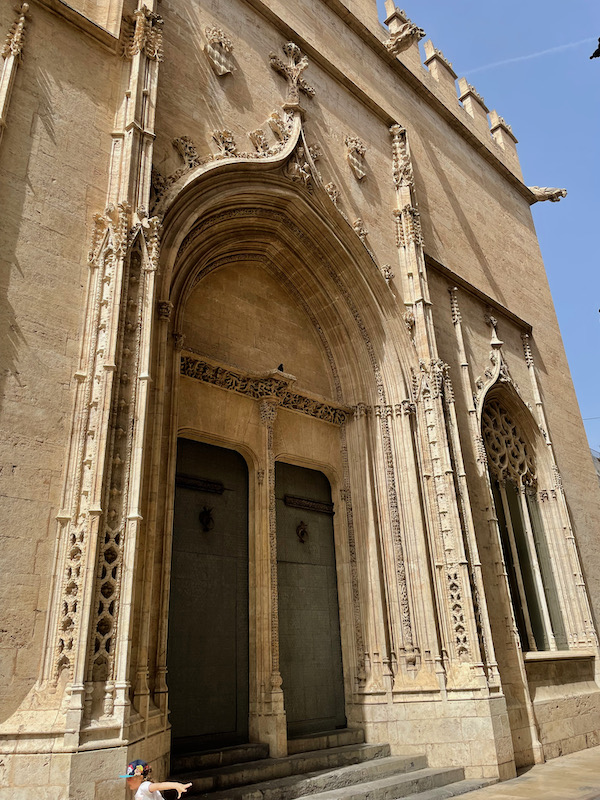
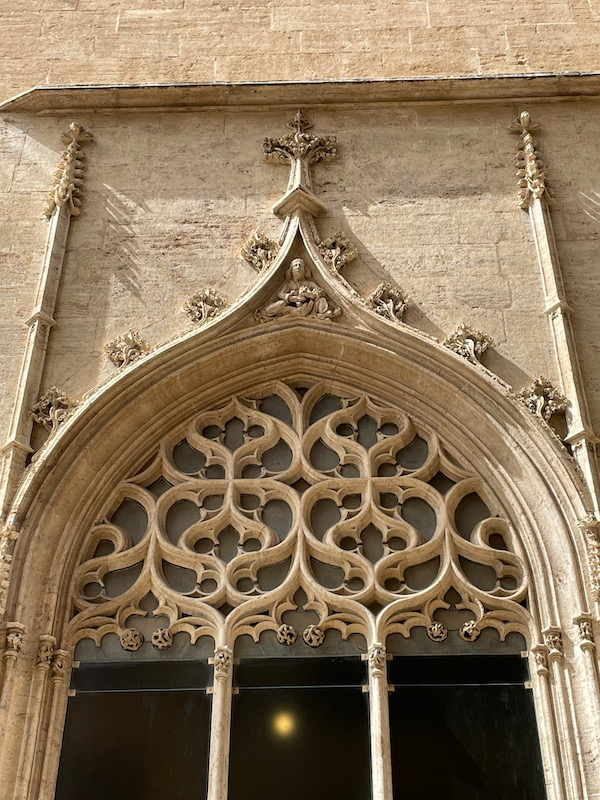
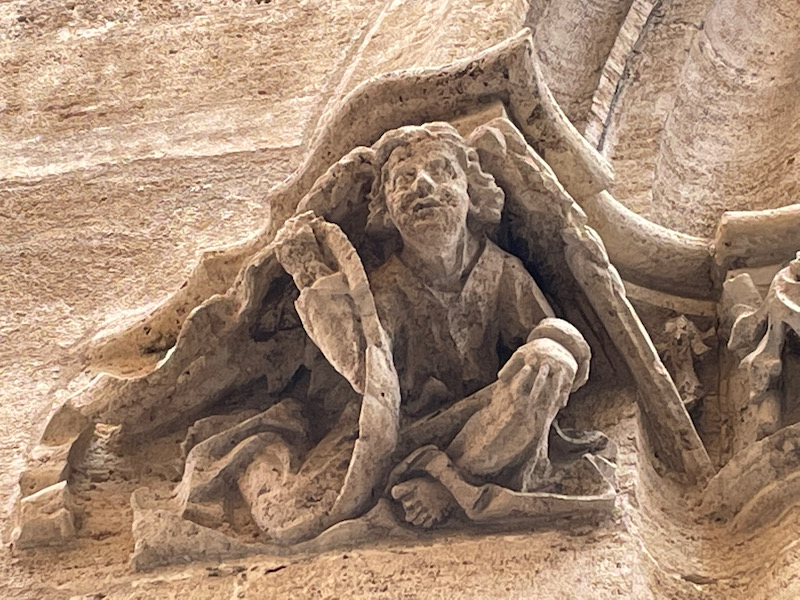
Nearby is the Plaça Redona, which is an interesting little shopping area. It is one of the smallest squares in the city and is, in fact, round. Inside were a set of shops, and they seemed to focus on lace and needlepoint. There were a set of ladies making lace and I took a few minutes to watch what they were doing.
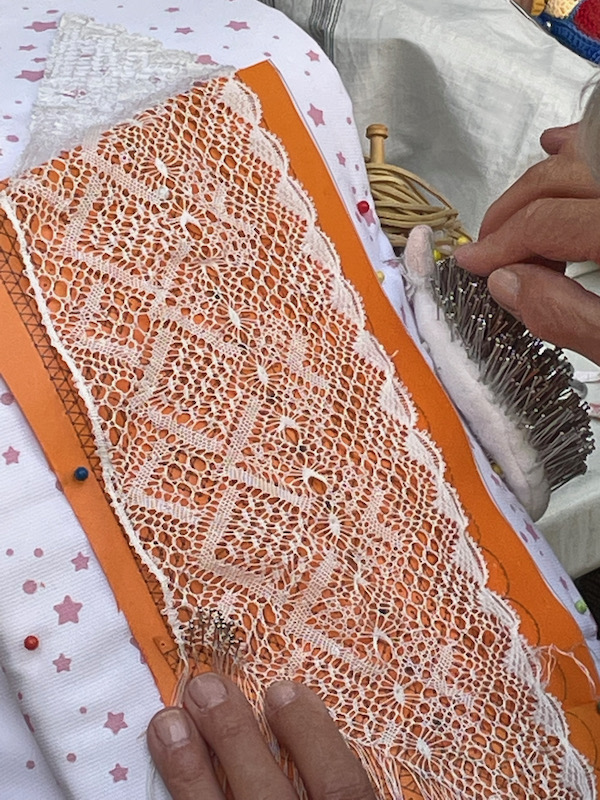
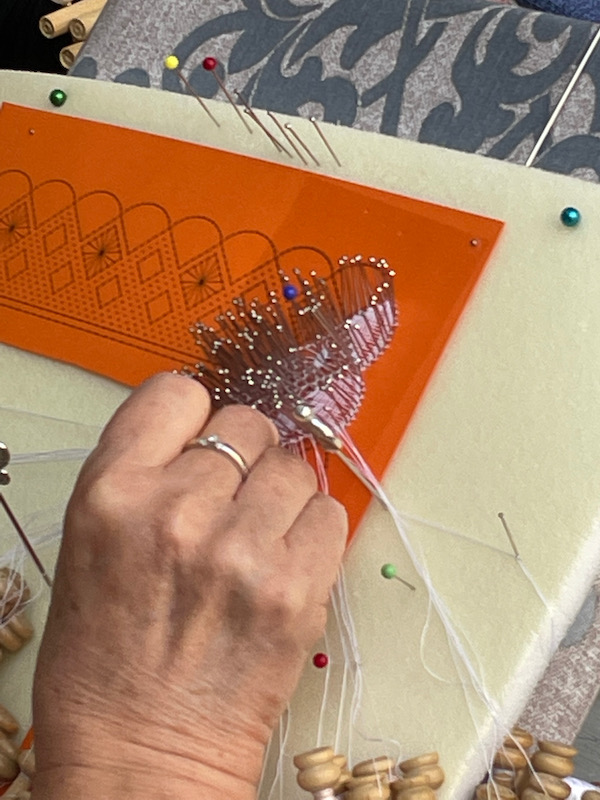
The Virgen de los Desemparados Basilica is dedicated to the patron saint of the city. It was built between 1652 and 1667 in the Baroque style of that period. One interesting thing about this church is that it is the only church in the old part of the city that was built totally new, from the foundations up, and not on an existing parish church or convent. I didn't get many pictures here, but I wanted to get a close-up of the painting in the dome.
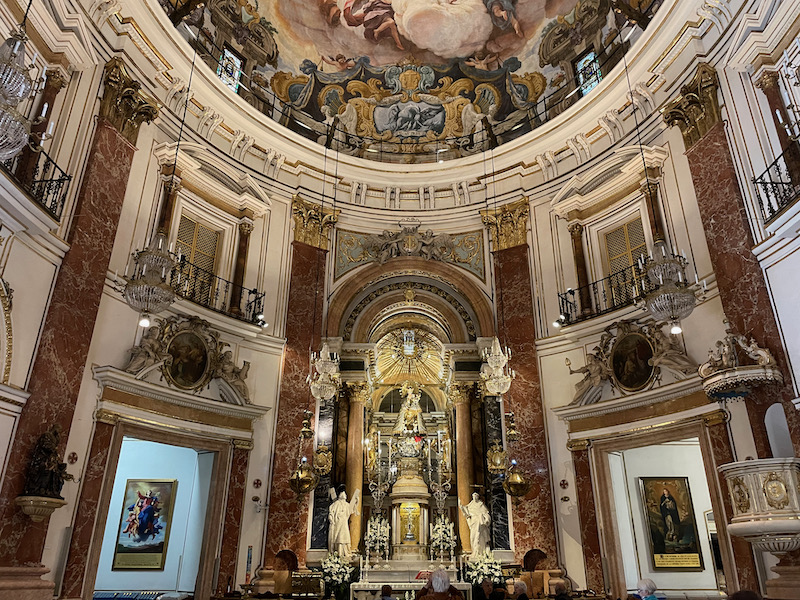
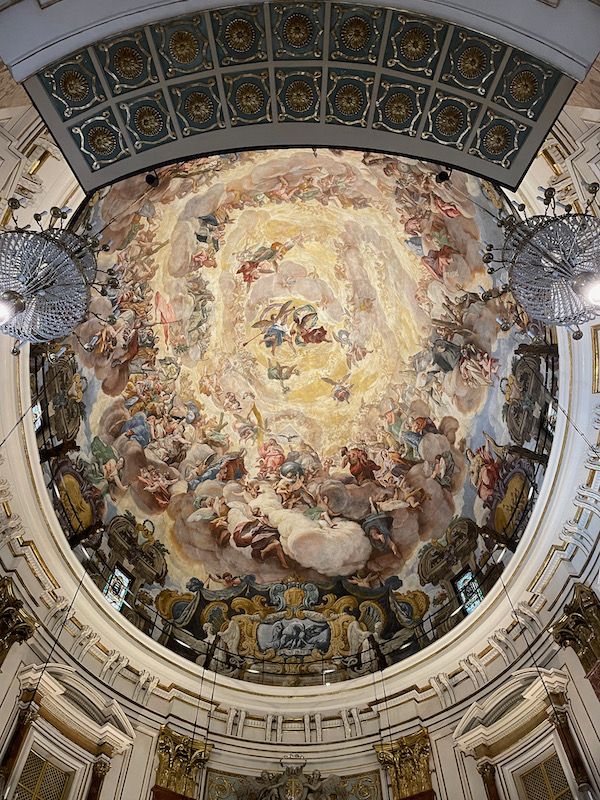
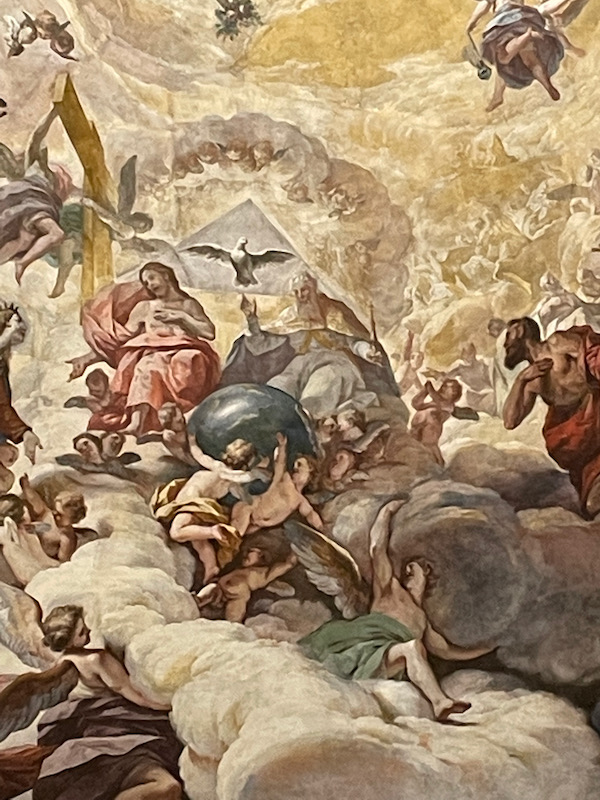
Valencia Cathedral, also known as St Mary's Cathedral was consecrated in 1238, and was built over the site of the former Visigothic cathedral, which had been turned into a mosque under the Moors. It is a generally-Gothic building but because the construction lasted from the 13th to the 15th century, you can also find Romanesque, Renaissance, Baroque, and NeoClassical elements here and there. For example, the Renaissance movement in the 15th century can be seen in the high altar, and sculptural decoration, such as the one in the Resurrection chapel. The main door of the cathedral, known as the "Iron Gate" was done in 1703, during the Baroque period. I have a few pictures from various sides, and you can see how non-church-like it looks. You have a very traditional-looking entrance in the first picture (although that is not the main entrance) but then you have the part on the left-side that looks like a Roman arena.
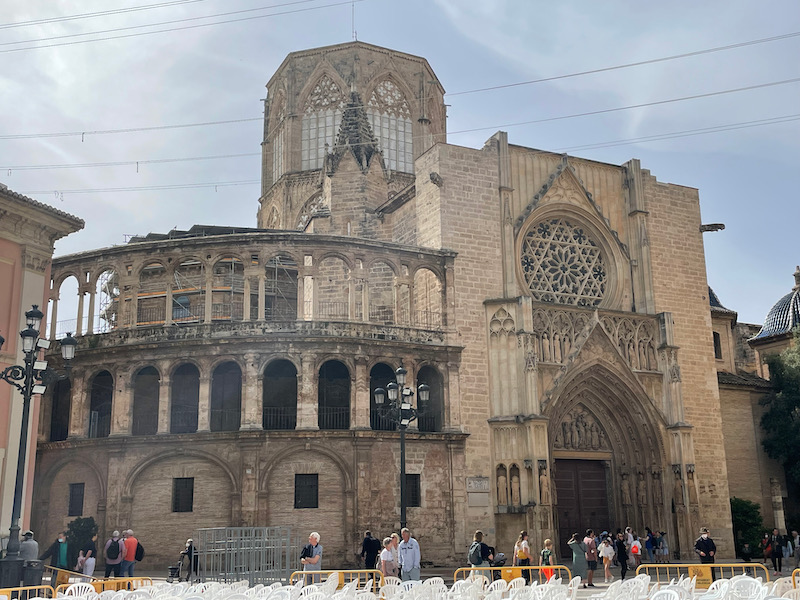
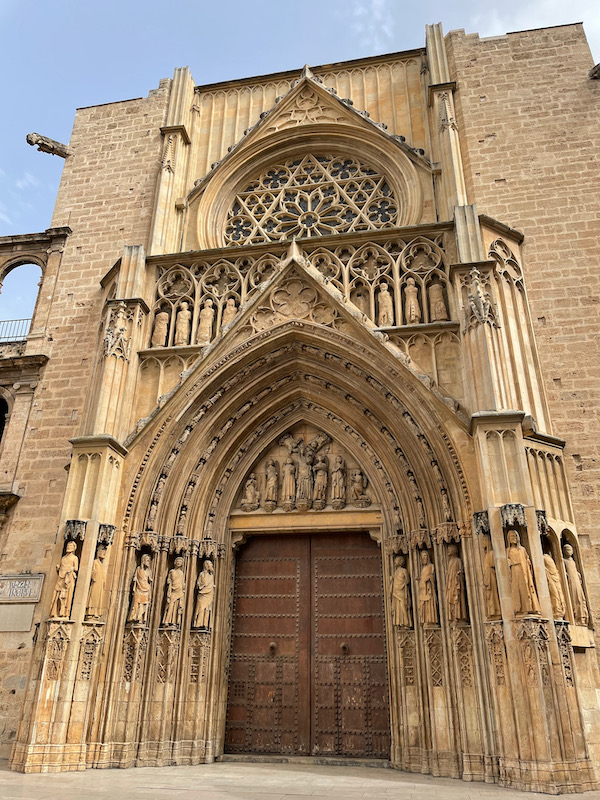
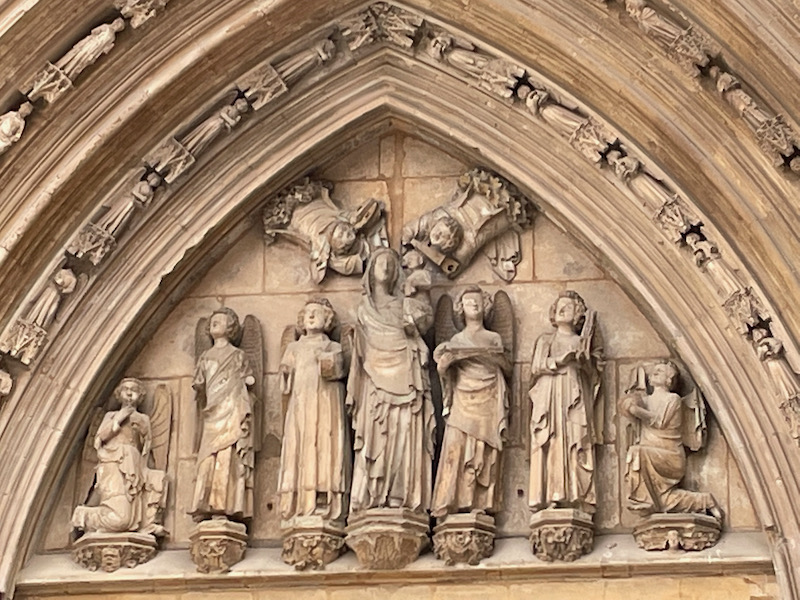
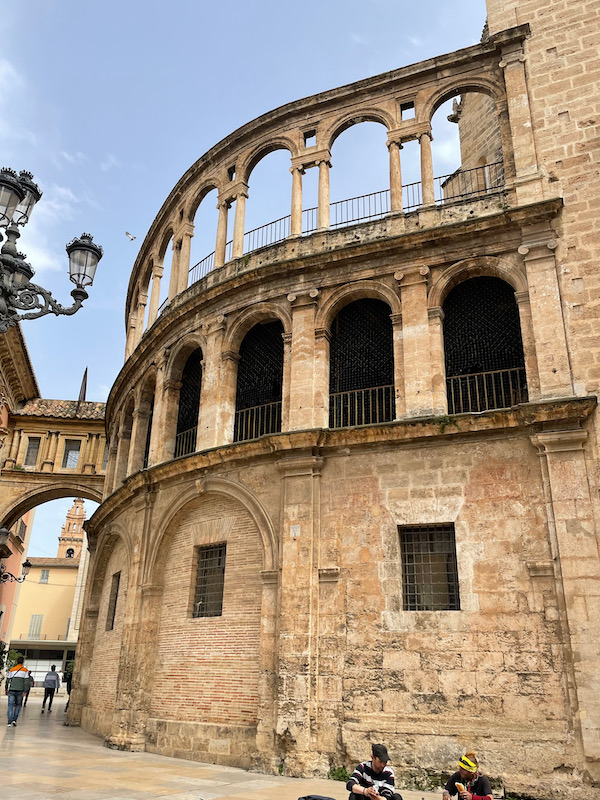
Around the corner is the main entrance, with the bell tower on the side. This tower, the Miguelete tower, was built in 1381 in a Valencian Gothic style. Originally it was a separate tower, and it was joined to the Cathedral at the end of the 15th century when the central nave was extended. A few close-ups of the Baroque decoration around this main entrance.
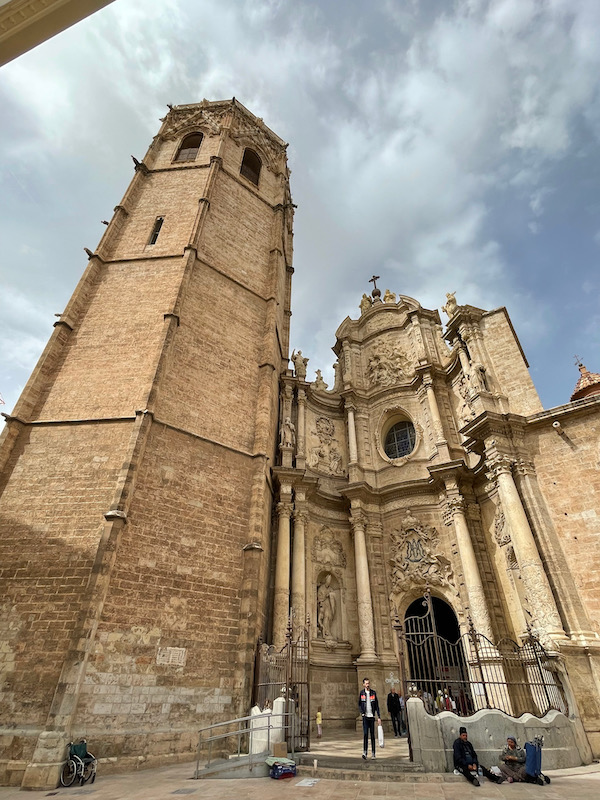
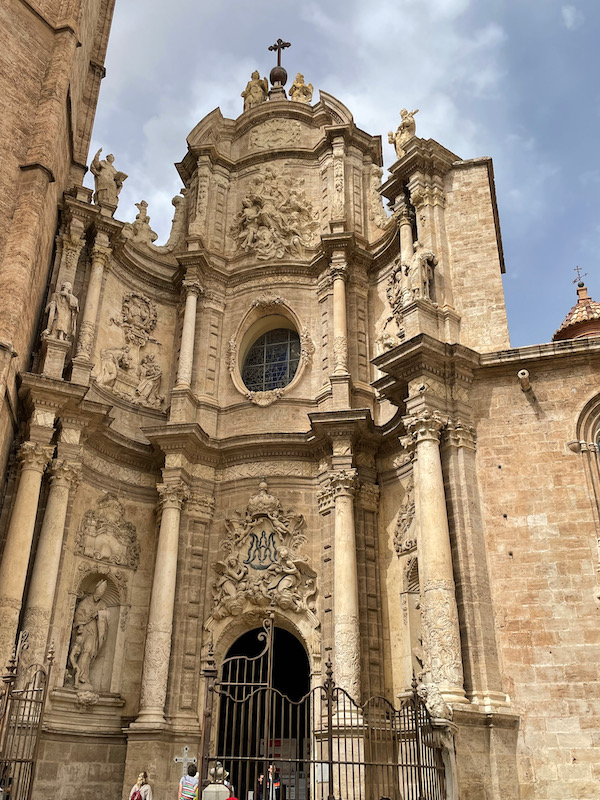
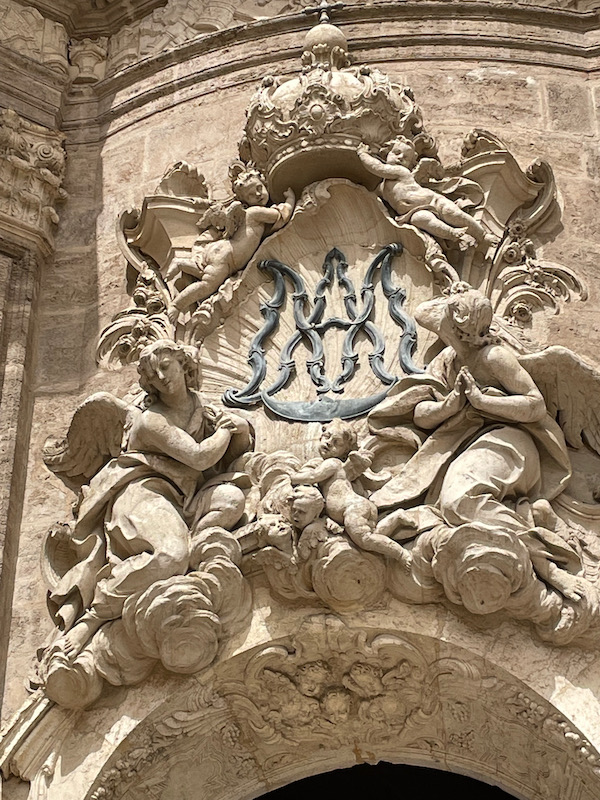
While the outside looks oddly-shaped, the main interior is quite traditional. You can see the nice Gothic arches and ribbed vaults.
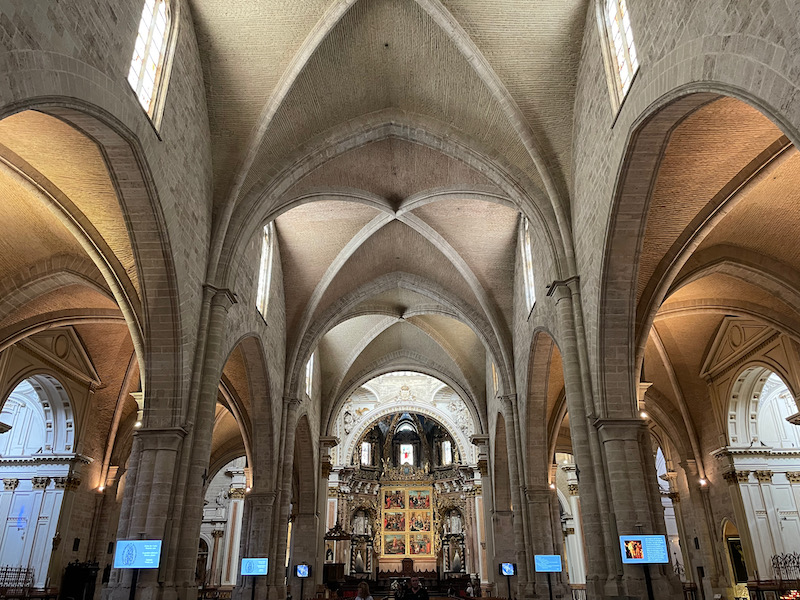
Chapel of San Pedro (Saint Peter) was built between 1696 and 1703 in the Baroque style, replacing an older Gothic chapel. It is highly decorated with frescoes and stucco medallions showing scenes related to Saint Peter. The entrance has a polychrome iron grille from the original 15th century chapel and then over it, gilded decoration showing the symbols of the four Evangelists: Matthew is represented by the angel, Mark by the Lion, Luke by the Ox, and John by the Eagle.
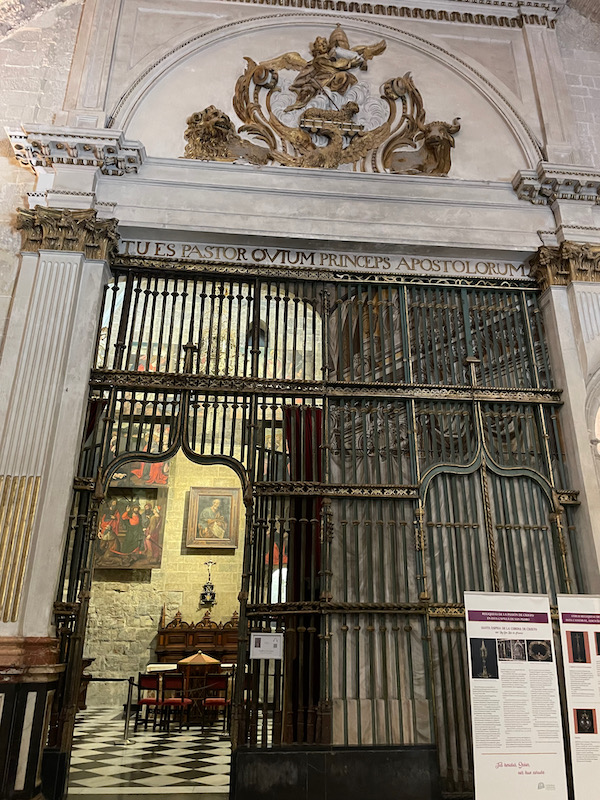
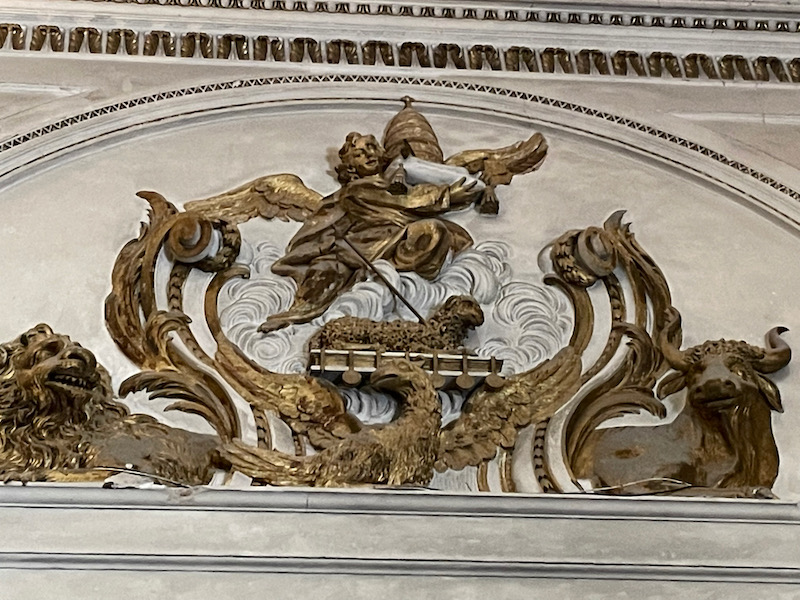
The back wall still has the original exposed stone along with 7 paintings. The 6 large canvases date from the beginning of the 16th century and show the main scenes in the life of the Virgin Mary (the Annunciation, the Birth of Jesus and the adoration of the shepherds, the Epiphany and the adoration of the Magi from the East, the Resurrection of the Lord, the Ascension into Heaven and, finally, Pentecost with the descent of the Holy Spirit on the apostles gathered around Maria). In the center is a smaller oil on canvas of Saint Peter from the 17th century.
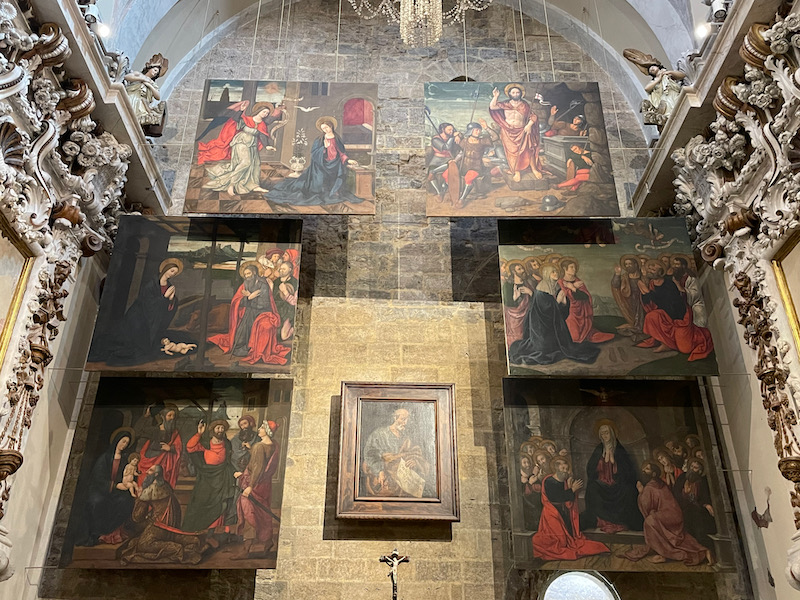
The side walls of the chapel have amazing stucco decor although the paintings have been damaged. These painted frescoes date from the 17th and 18th century but were almost lost due to a fire in 1936 during the Spanish civil war.
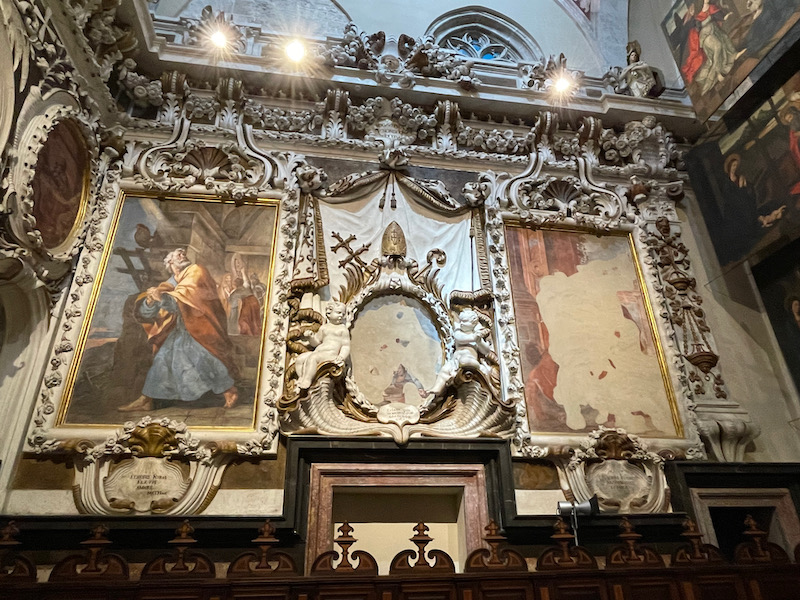
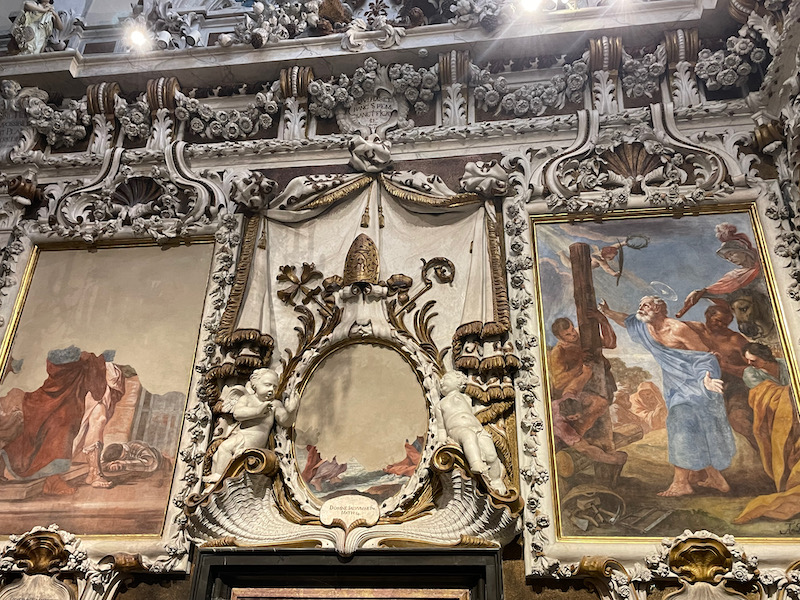
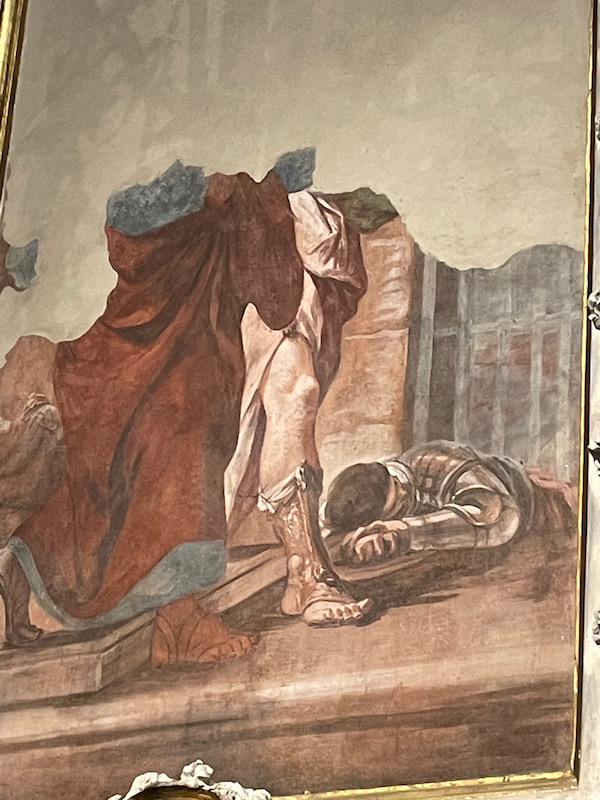
Chapel of San Francisco de Borja has a couple nice paintings, including this one from 1787 showing San Fransisco de Borja with the corpse of Empress Isabel. He is dressed as a knight of the order of Santiago, he lifts the cloth that covers the face and hands of the deceased and feels God's call to abandon the vanities of the world.
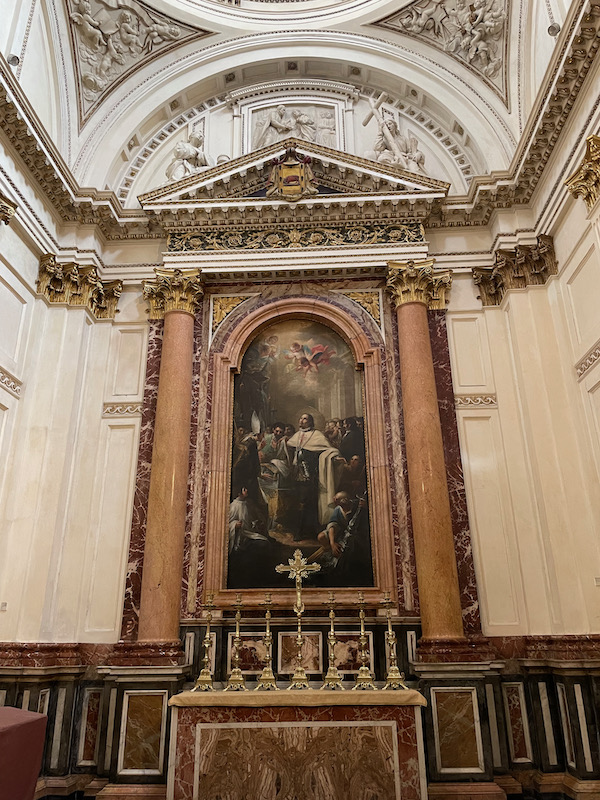
Chapel of Saint Dionysius and Saint Margaret has a really nice retable from the late 15th century). In the middle are Saint Dionysius, the first bishop of Paris in the 3rd century and Santa Margarita, martyr of the 3rd century. Around the retable are other images, including the Adoration of the Magi, Calvary and Apparition of the risen Jesus to the Virgin Mary, and Scenes from the passion.
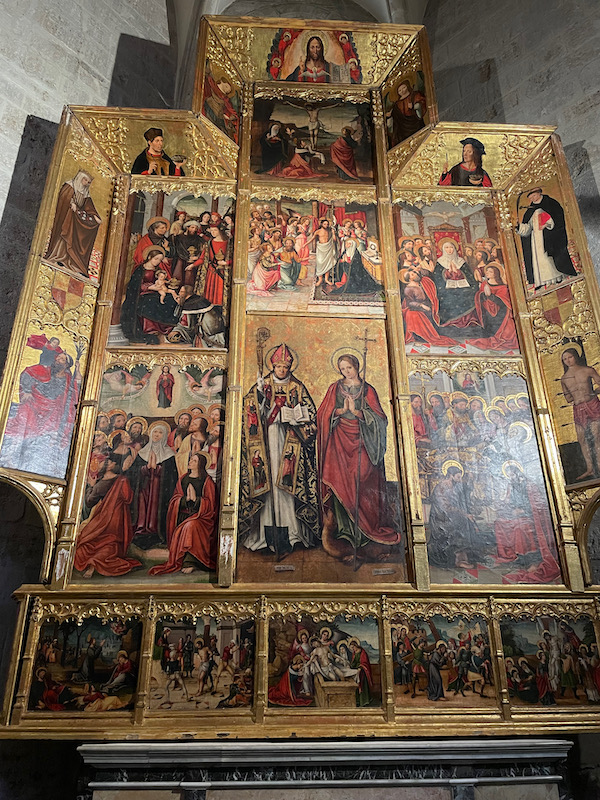
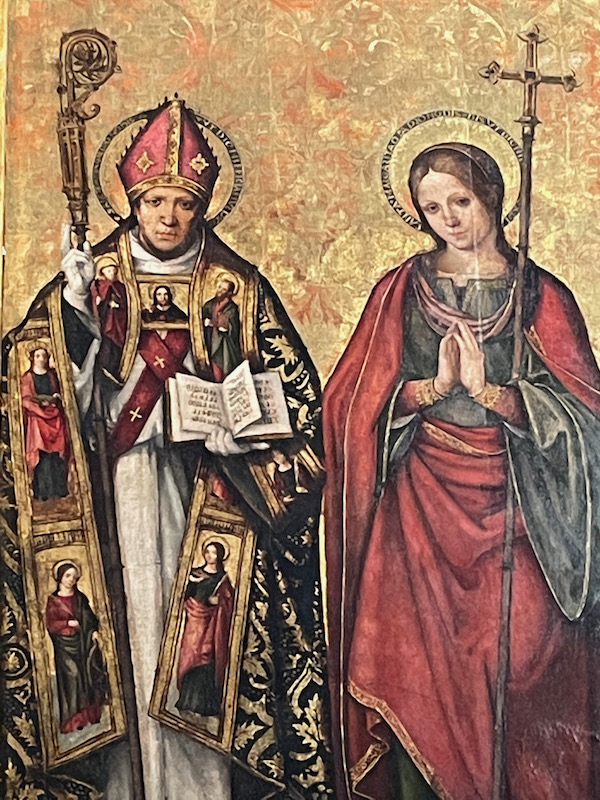
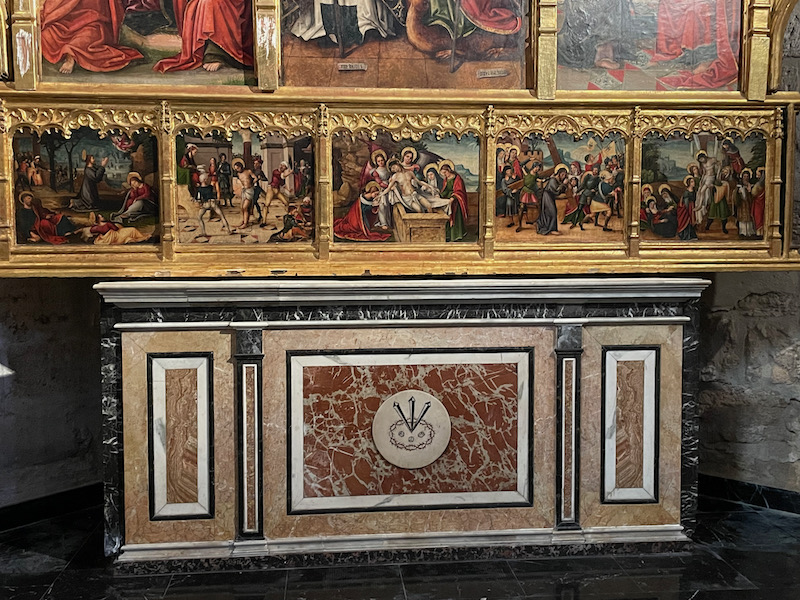
A few of the more interesting stained glass windows. The first is a commemorative stained glass window from 1962, celebrating of the 700th anniversary of the laying of the first stone of the Cathedral in 1262. The heads represent the married couples sculpted as corbels on the cornice of the 13th century Romanesque door of the Palau. The next is not actually stained glass, but thinly cut alabaster. This is used in almost all of the upper windows to let the light shines through better. The 3rd picture is a Gothic rose window from the 14th century, showing the outline of the star of David with the cross in its center.
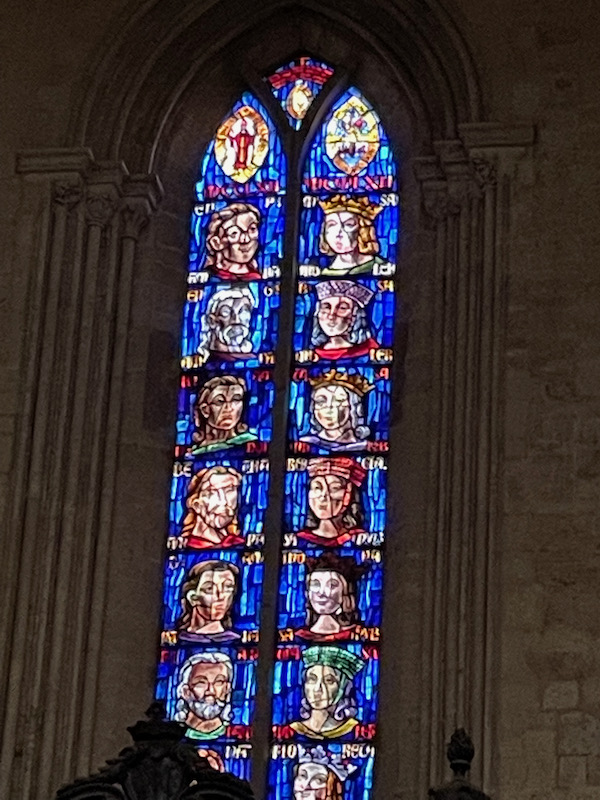
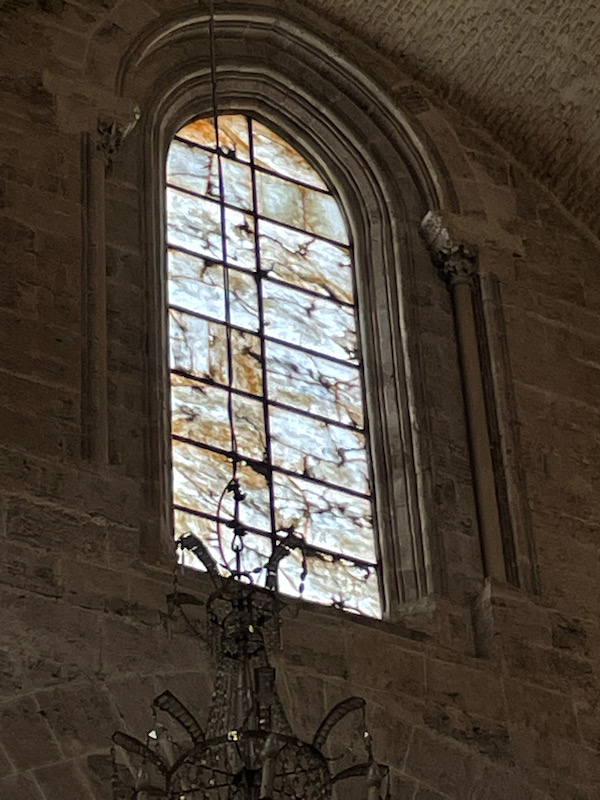
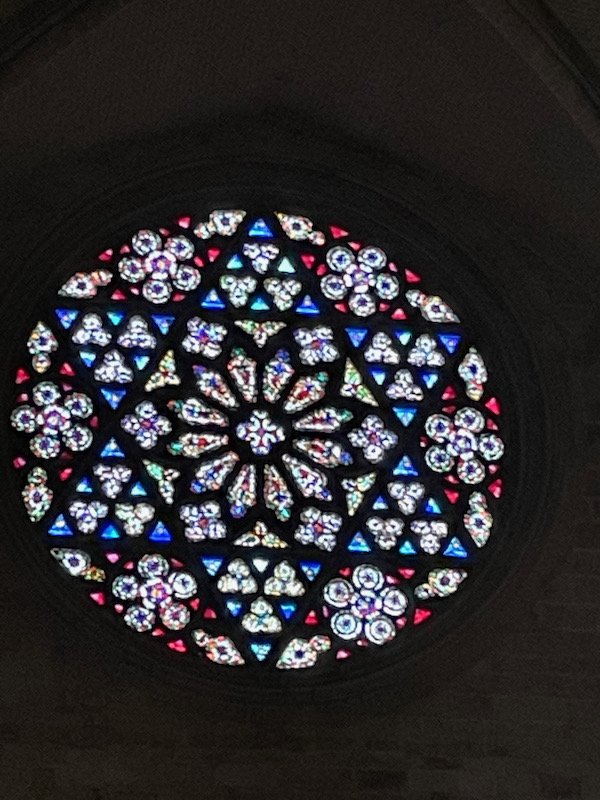
We are now at the main altar area. Above the transept is a Gothic-style lantern tower, crowned with a dome. The octagonal floor plan makes the ribs look like flower petals. It has 2 sets of windows that, like the one we saw earlier, is made of thin alabaster. The 4 Evangelists are represented in some of the corners. You can recognize them with their attributes (John with an eagle, Luke with a bull, Matthew with an angel, Mark with a lion).
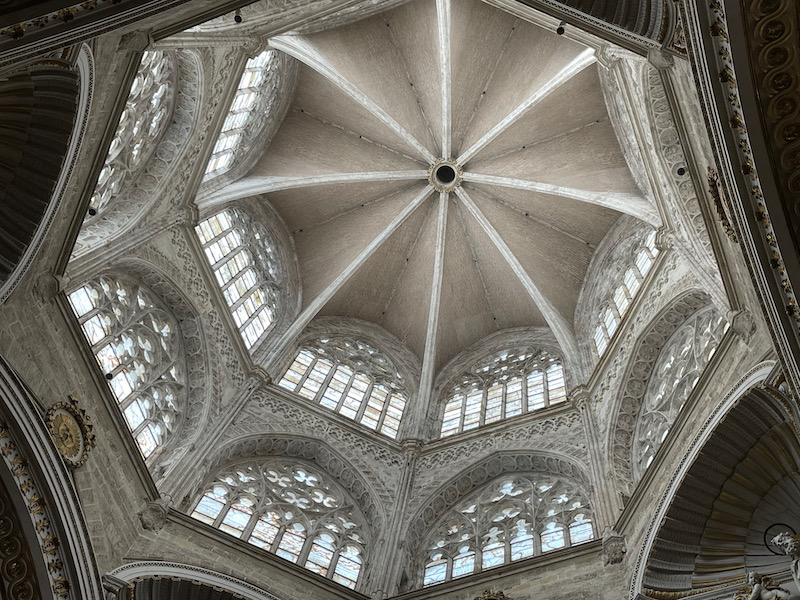
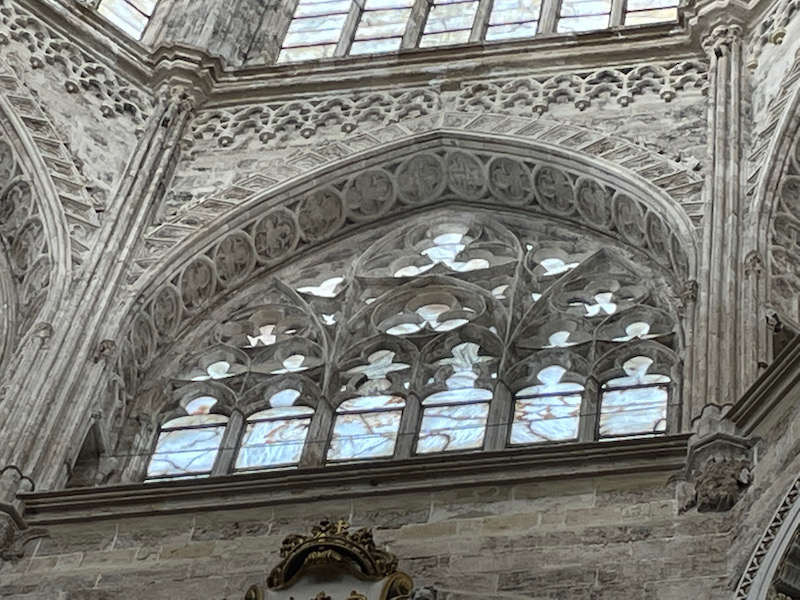
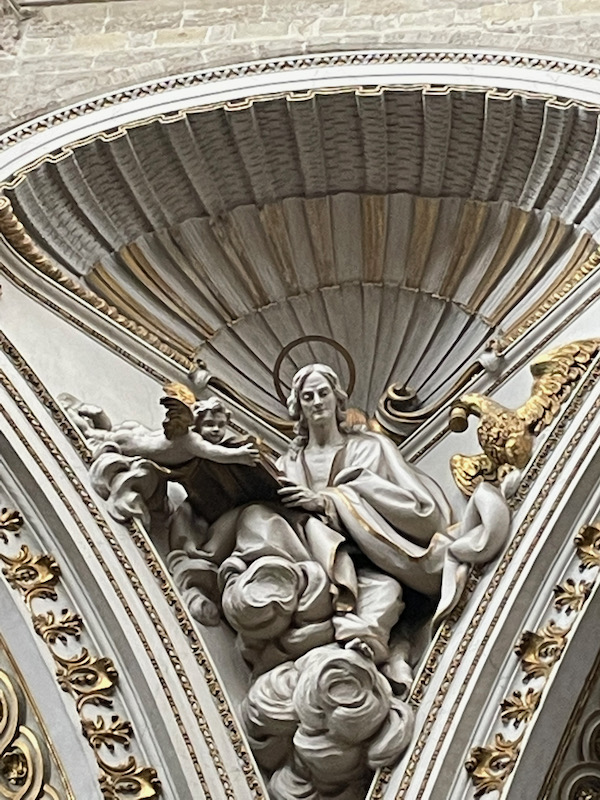
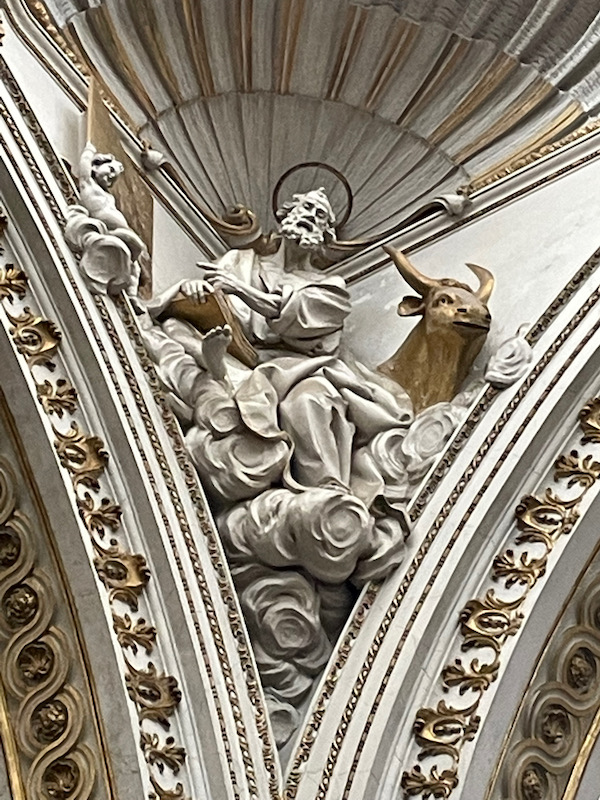
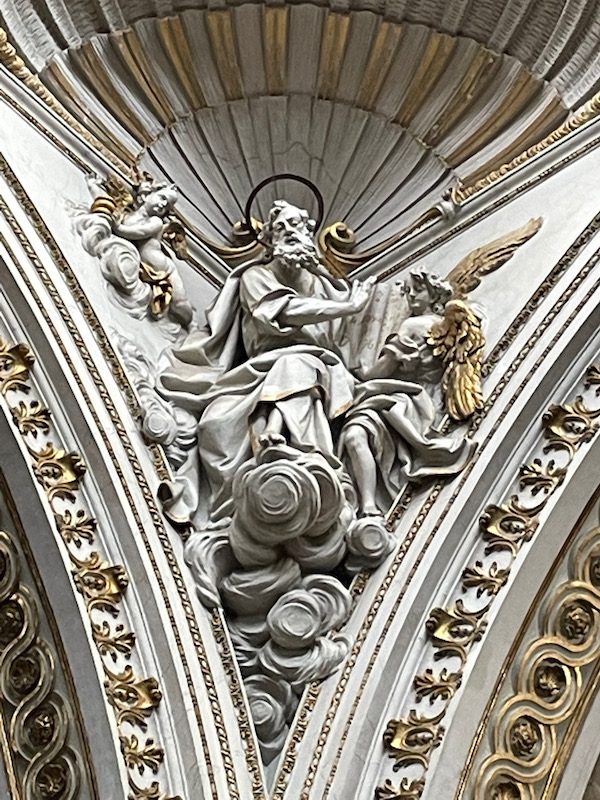
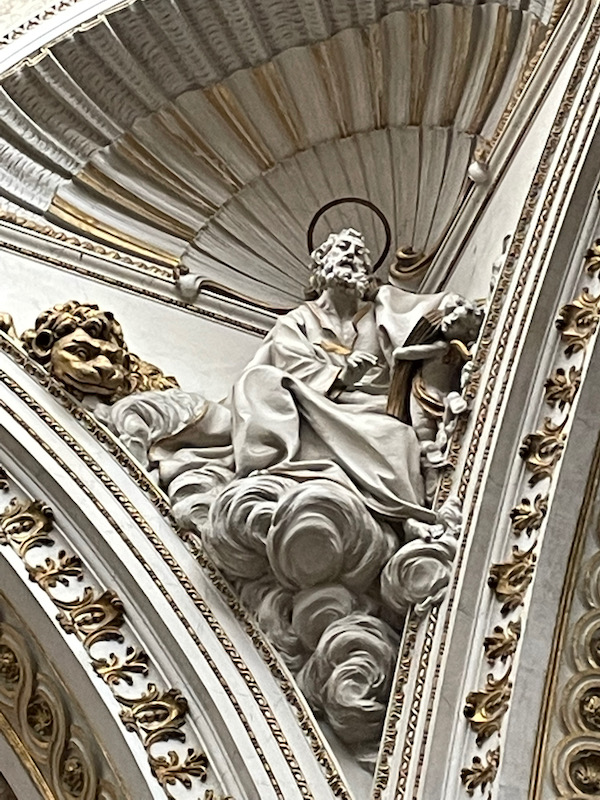
In 1462, a fire destroyed all of the decorations in the apse. When the future Pope Alexander VI came to Valencia, he brought a set of Italian painters with him, who were given the job of redoing the decorations in the dome. In the 17th century, a new Baroque dome was installed over the previous one, hiding those decorations. Fast forward to 2004 when work began to restore this Baroque dome this started and the original paintings were discovered. They show 10 angels playing musical instruments.
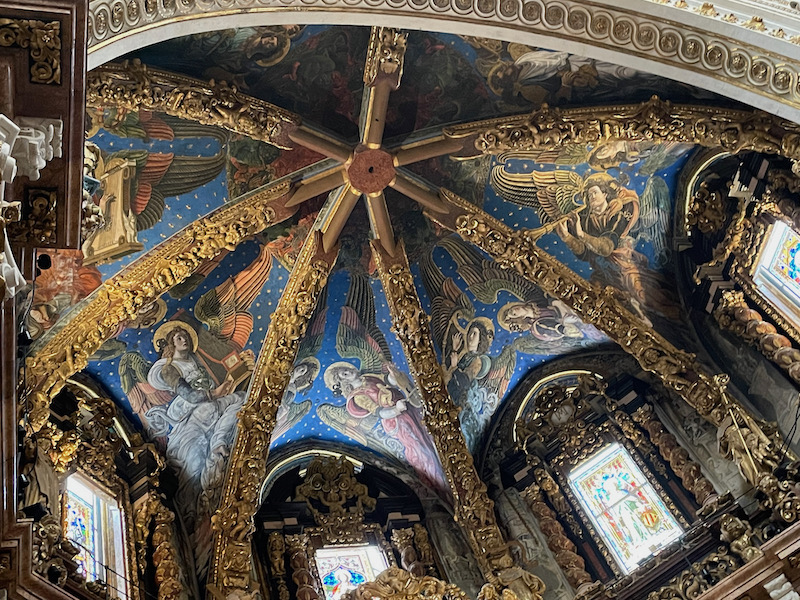
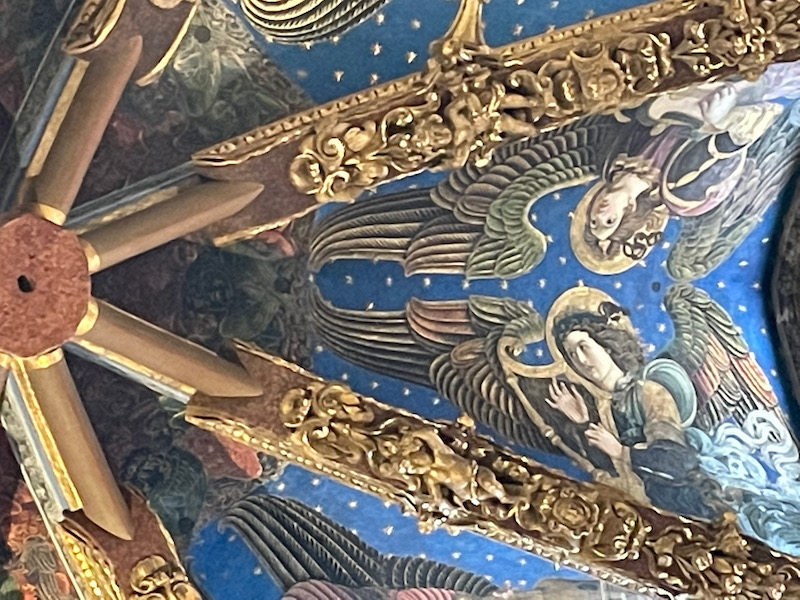
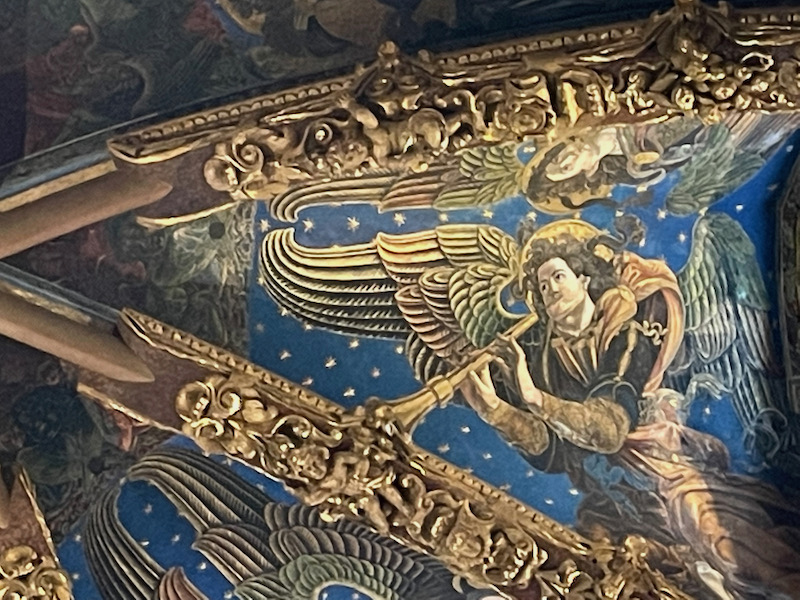
The high altarpiece is interesting in that it has an outside (which we can see) but also an inside, which is only visible certain times of the year. Here we can see the adoration of the shepherds, the adoration of the Magi and the resurrection of the Lord on the left. Then on the right are the ascension of the Lord to heaven, the descent of the Holy Spirit and the death and assumption of the Virgin.
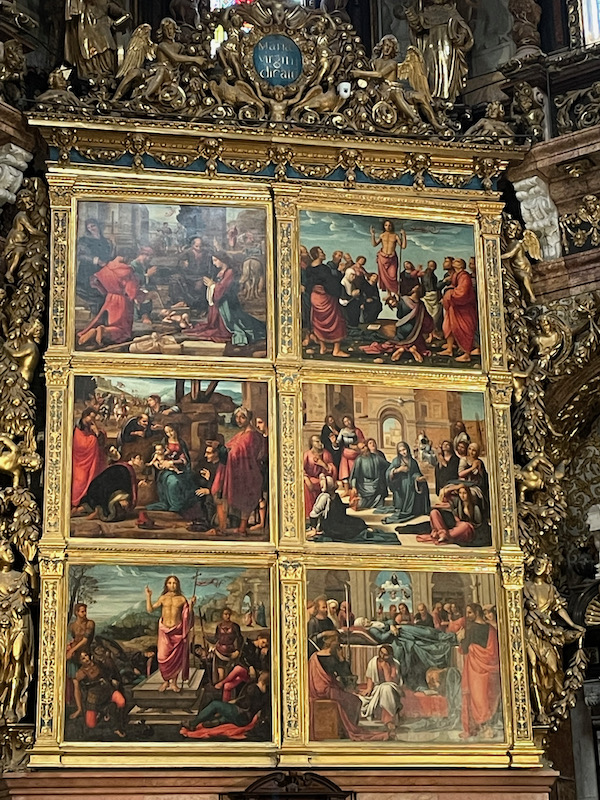
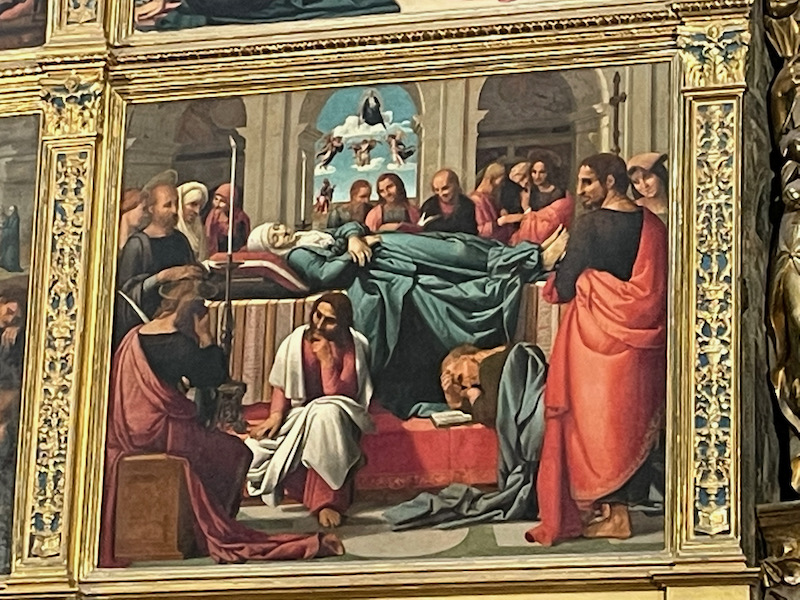
In the ambulatory are two interesting things. First is the left arm of San Vicente Mártir, deacon of Zaragoza, who was martyred in Valencia around the year 304. The silvered bronze reliquary holding the arm was made in Padua.
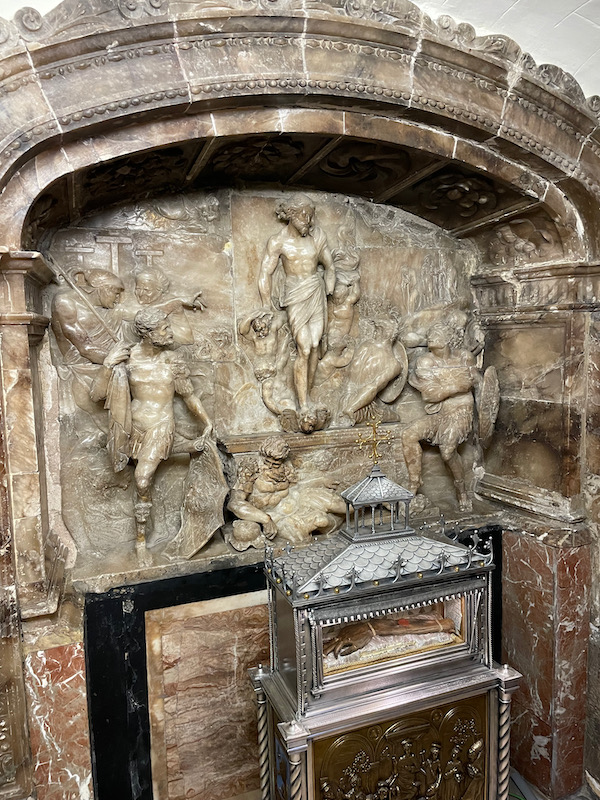
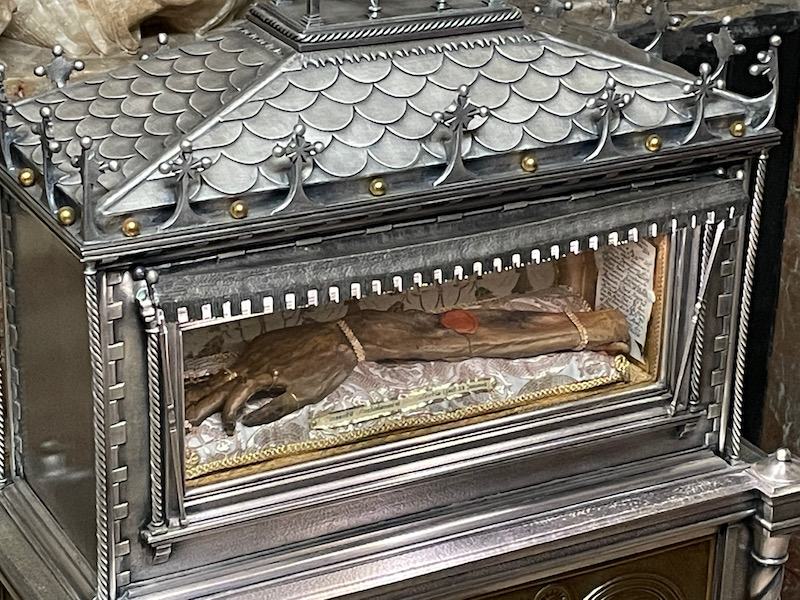
Also in the ambulatory is a polychrome alabaster stone statue of Mary. In the 18th century, it was placed over the entrance to the neoclassical choir and with the the wooden throne decorated in gold. In 1939, when the choir was moved to the apse, the image was moved to the ambulatory.
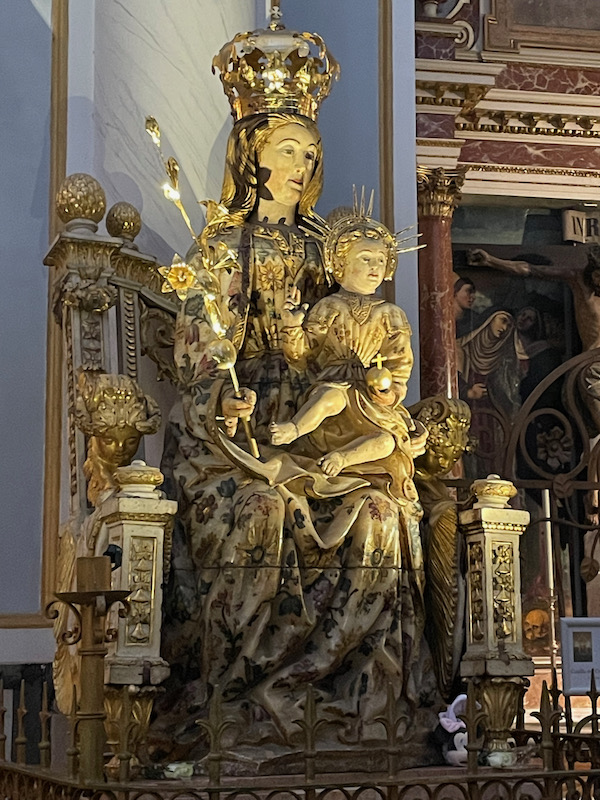
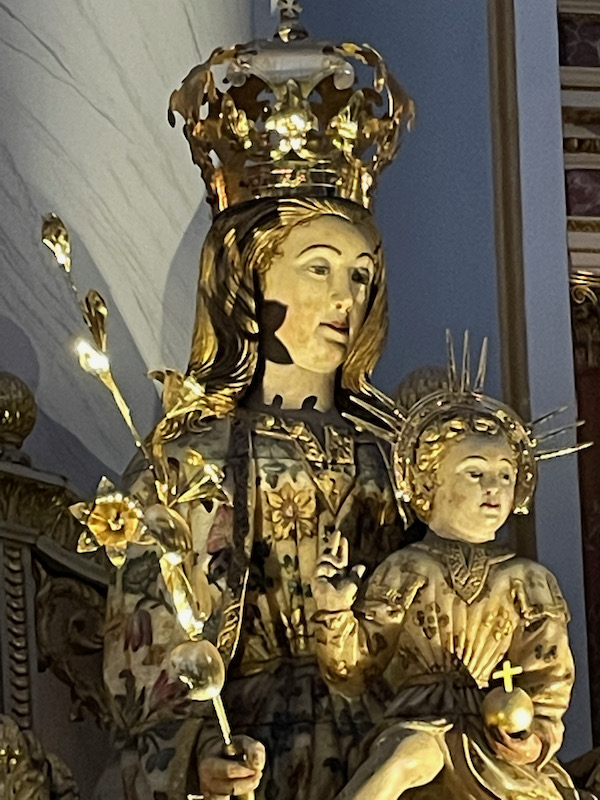
And now the most important part, the Chapel of the Holy Chalice. It is covered with a high ribbed vault in the shape of a star whose ribs extend until they rest on polychrome corbels.
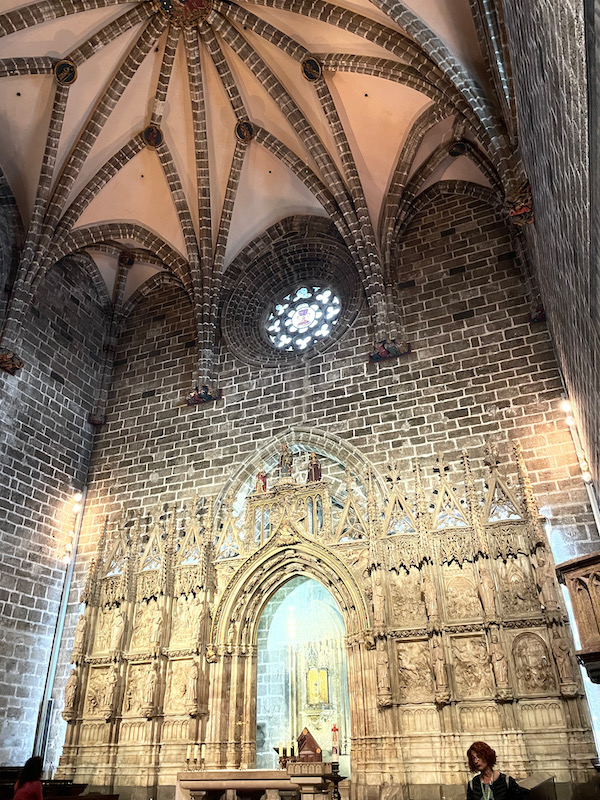
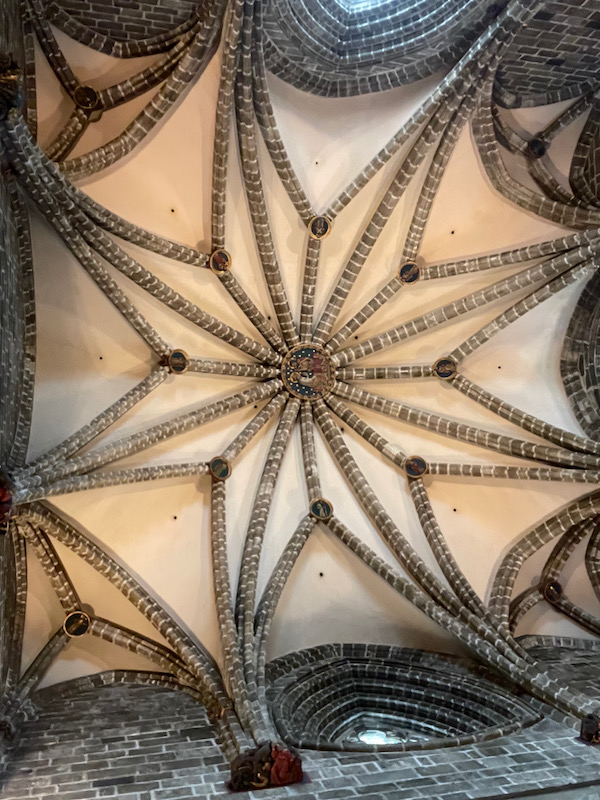
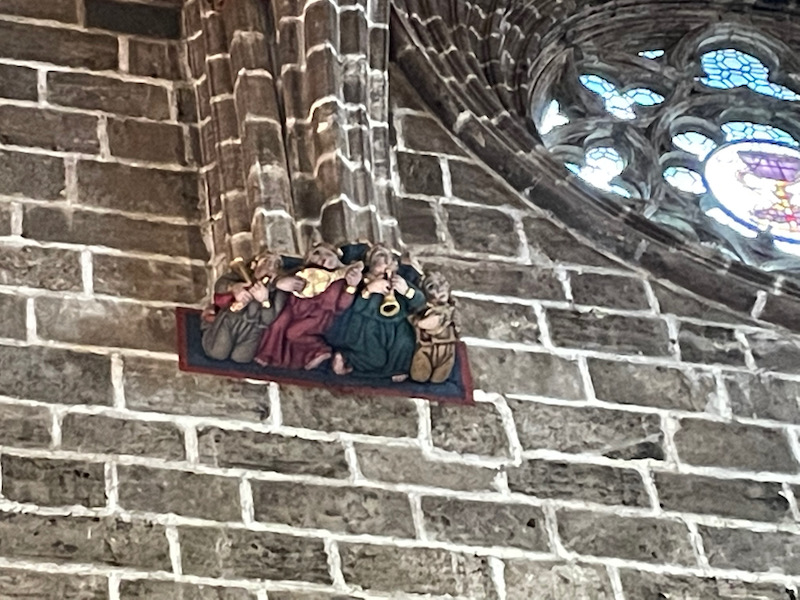
The alabaster altarpiece is actually an old choir door from the 15th century, topped by images of the Virgin, with Saint Louis and Saint Helena. The lower scenes correspond to the Old Testament and are a prophecy of the upper ones, from the New Testament.
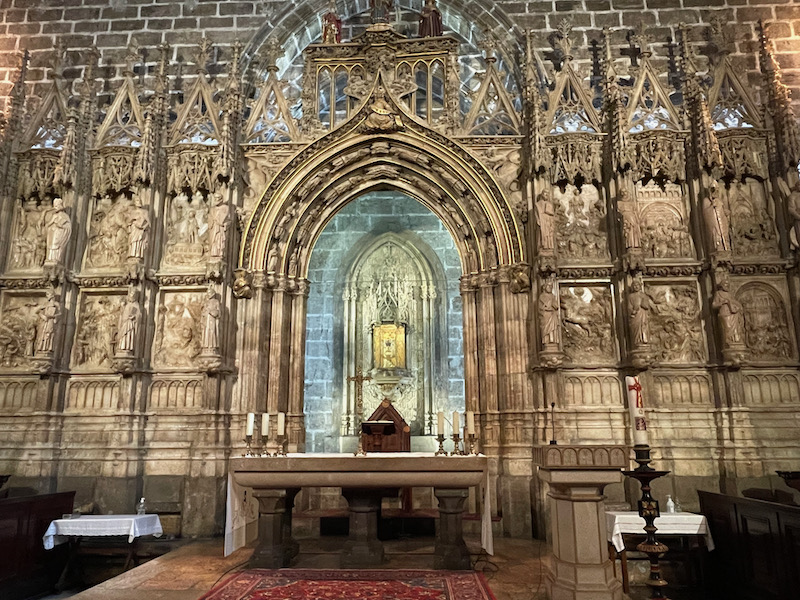
In the middle of the altarpiece is the Holy Chalice, or the "Holy Grail". The Holy Chalice of Valencia is an agate dish with a mounting for use as a chalice. The bowl may date to Greco-Roman times, but its dating is unclear, and its history is unknown before 1399, when it was gifted to Martin I of Aragon. By the 14th century an elaborate tradition had developed that this object was the Last Supper chalice.
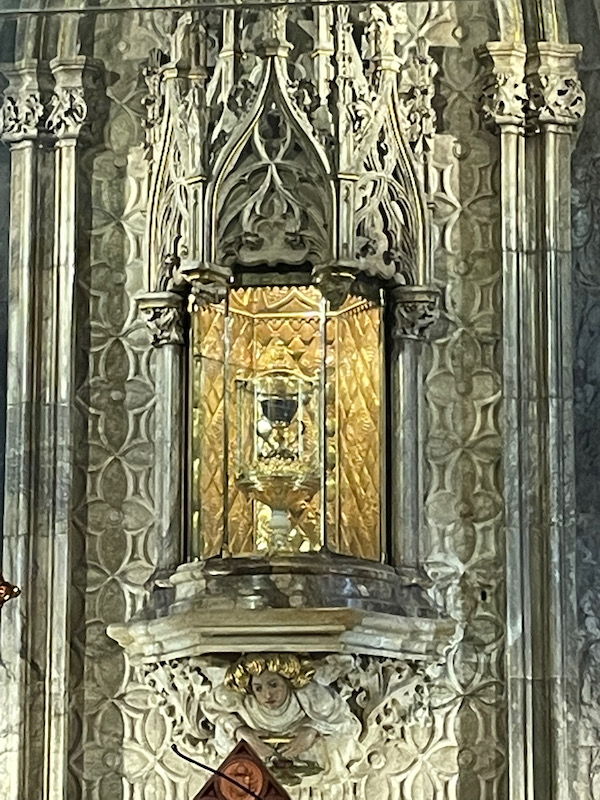
Palace of the Marquis of Dos Aguas is a Rococo palace built during the 15th century by the family Rabassa de Perellós, who had acquired the barony of Dos Aguas in 1496. Most of what we see today comes from a large renovation project in 1740 that changed most of the exterior to the Rococo style. While everything is rather "over-the-top", the main entrance is impressive. It is carved from alabaster and has the 2 figures on around the door that represent the two main rivers in the province of Valéncia: the Júcar and the Turia. Above the entrance, you can see an image of the Virgin of the Rosary and various other decorative elements. The rest of the building is painted to represent different colors of marble, and additional carved decorations around and over all of the windows.
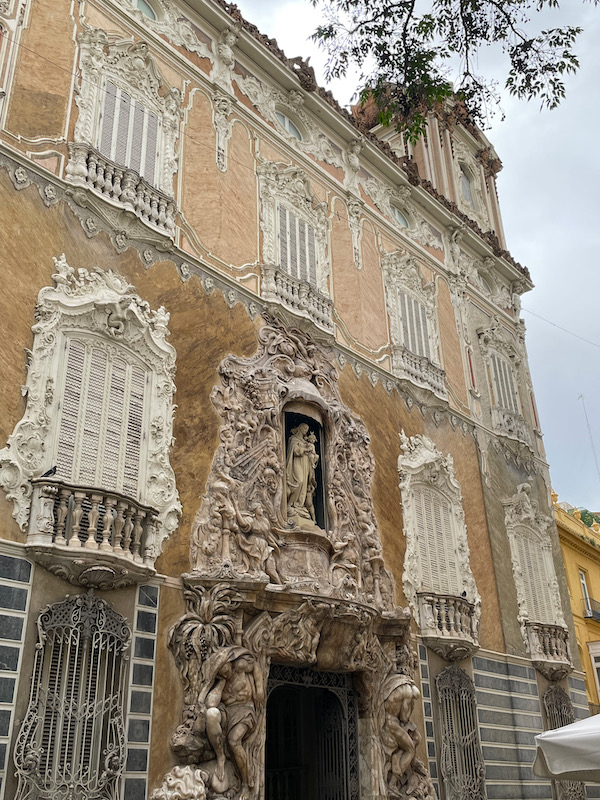
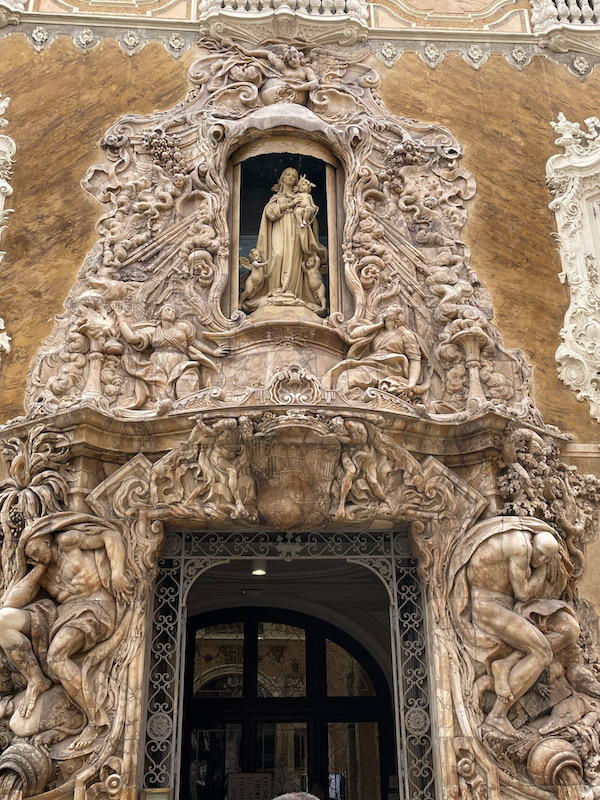
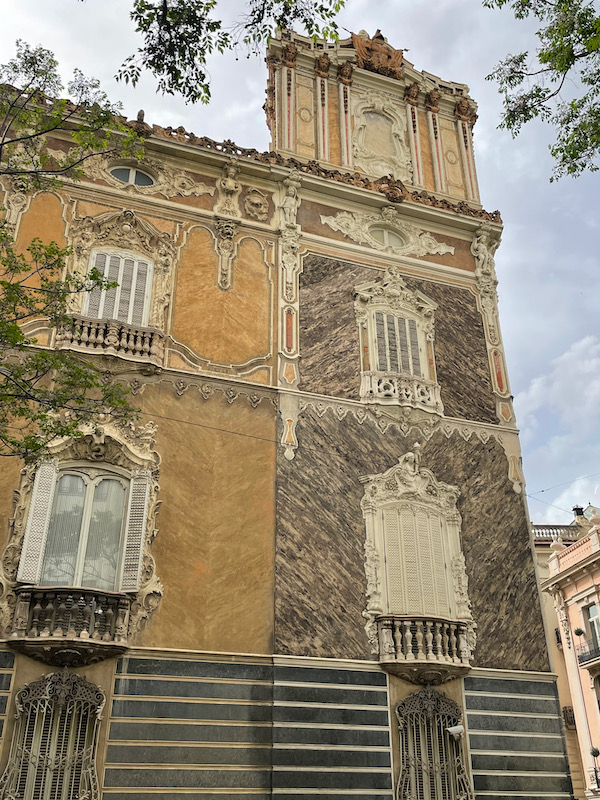
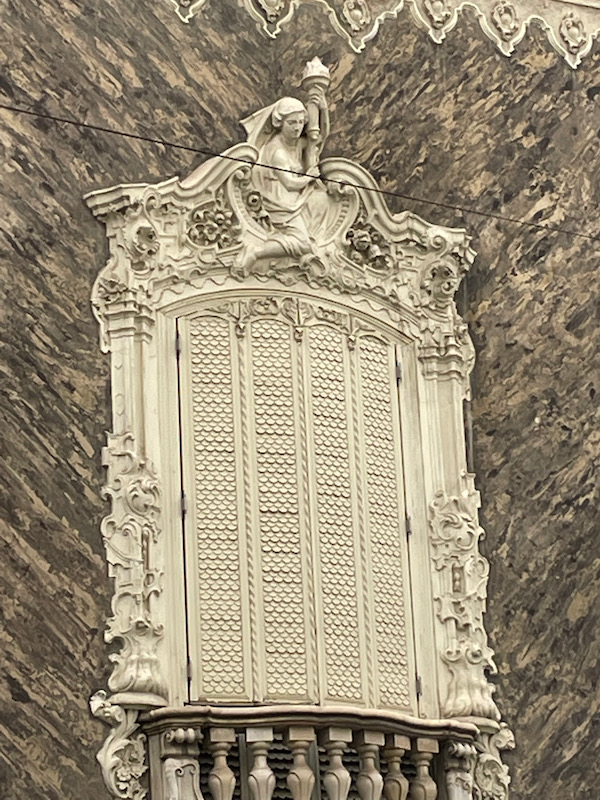
As we left Valencia, we headed out to a puppy-friendly beach, located next to the shipping port. It was HUGE and a wonderful sand beach. Lucy had a great time digging, running, and playing in the sand.
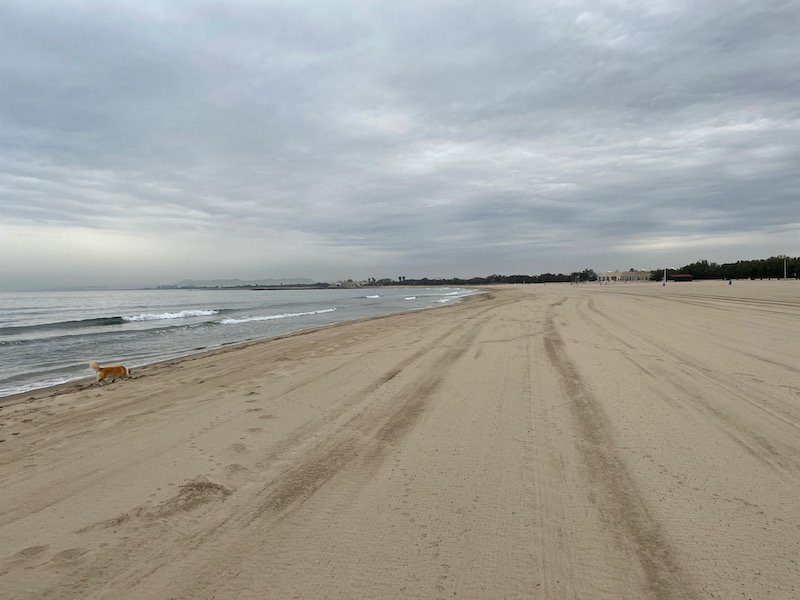
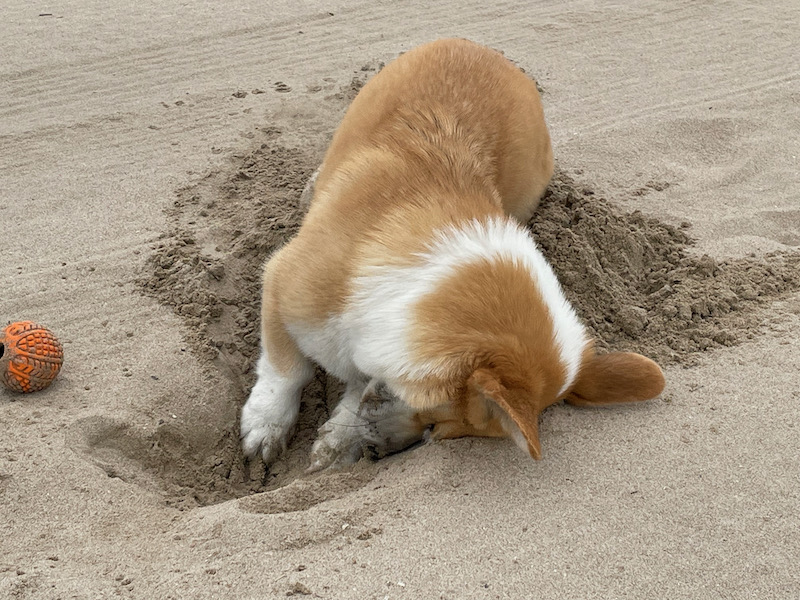
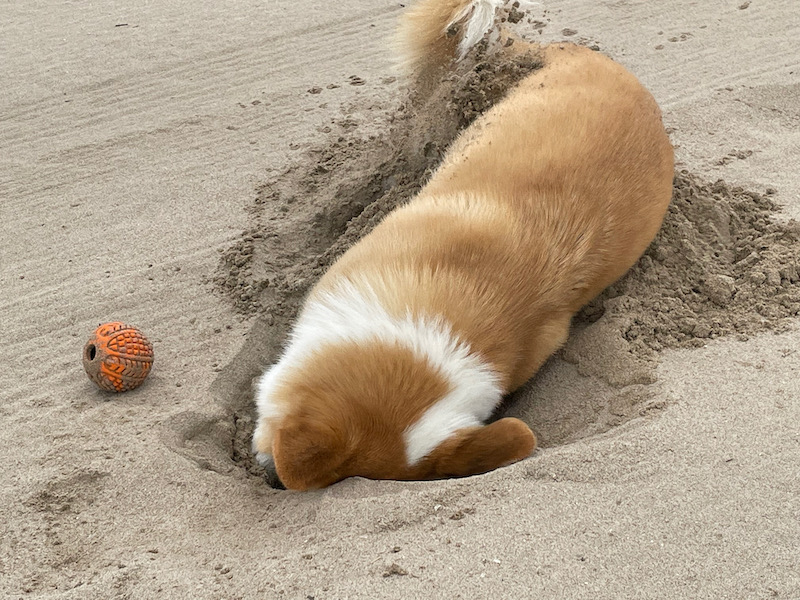
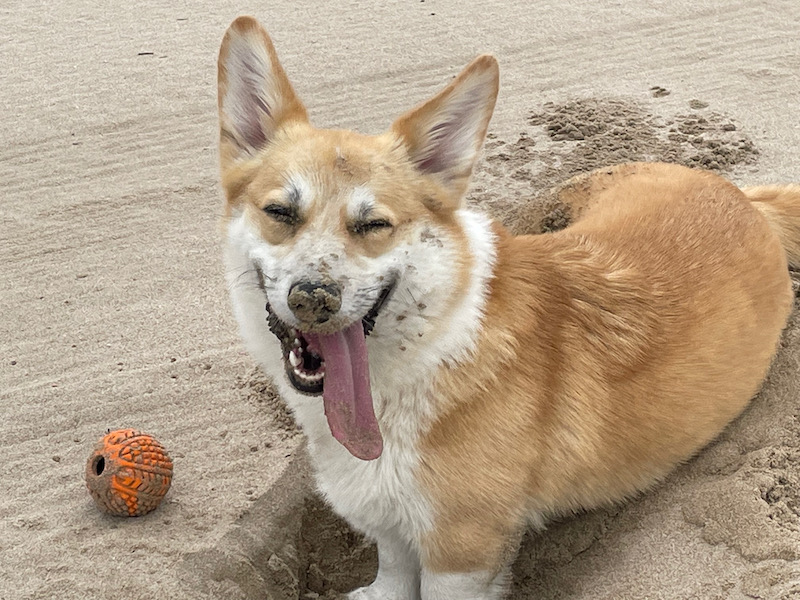
We met up with a couple other dogs in one section that was a bit more rocky, and Lucy got to play with one of them for a couple minutes. They got a bit aggressive here and there, but Lucy didn't seem to mind too much.
And this is one of Lucy's favorite past-times .... playing with the ball! She gets SOOOO excited, hopping around ... I find it really cute!